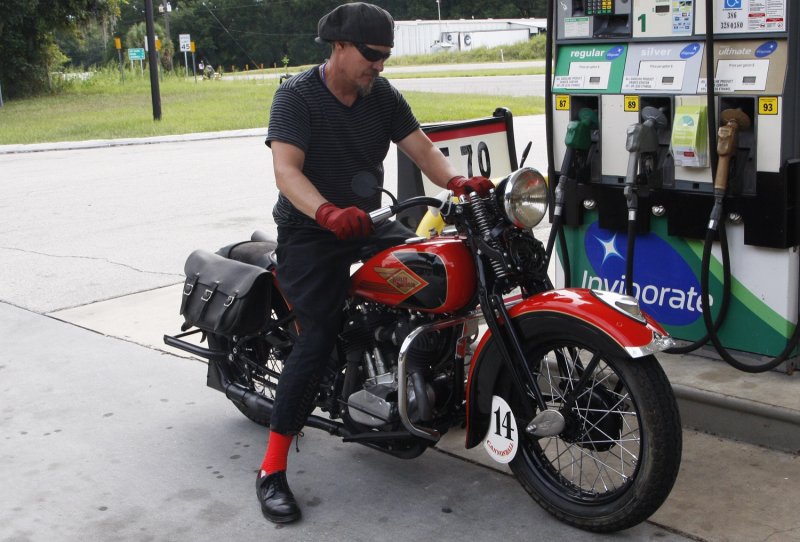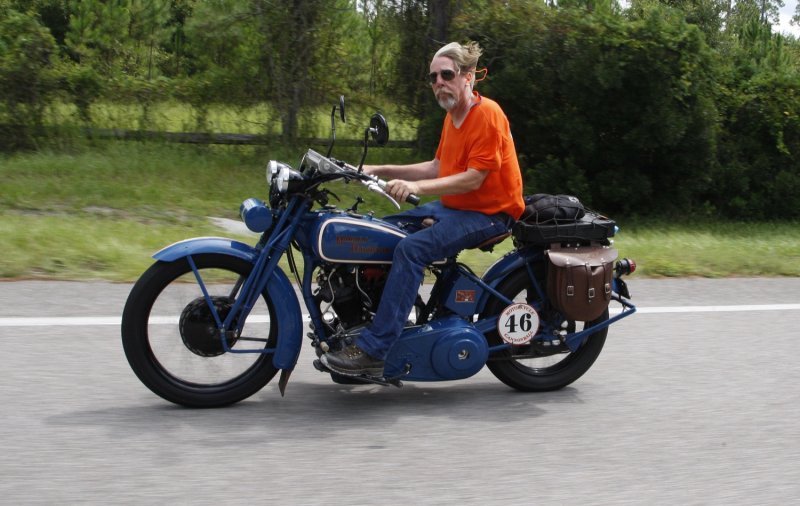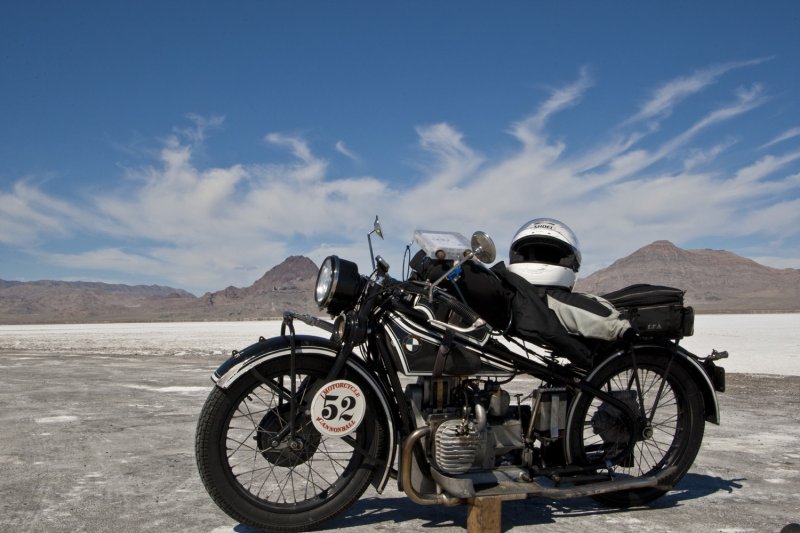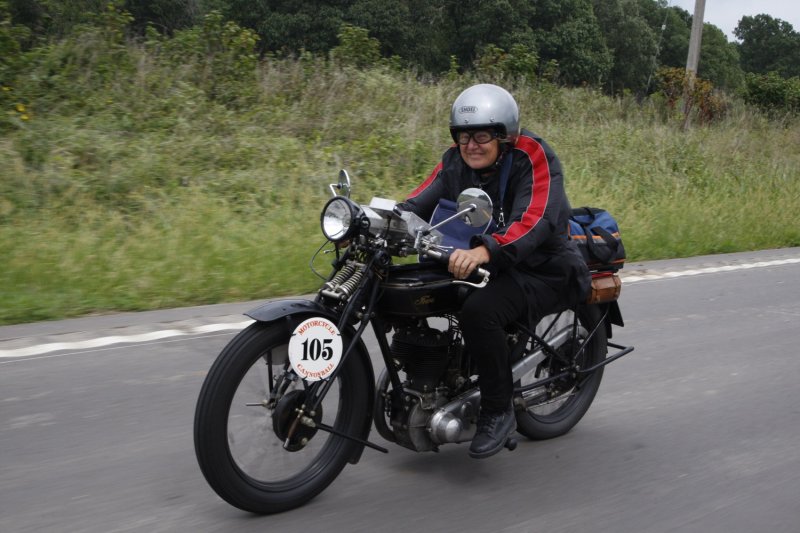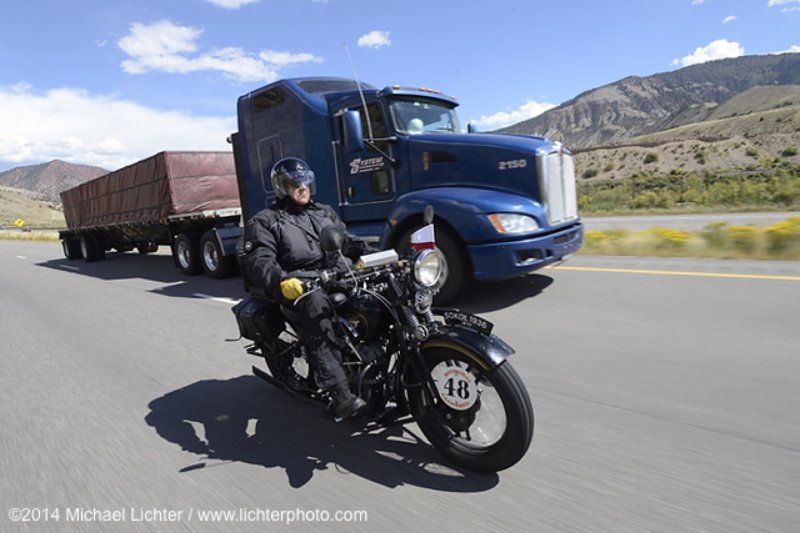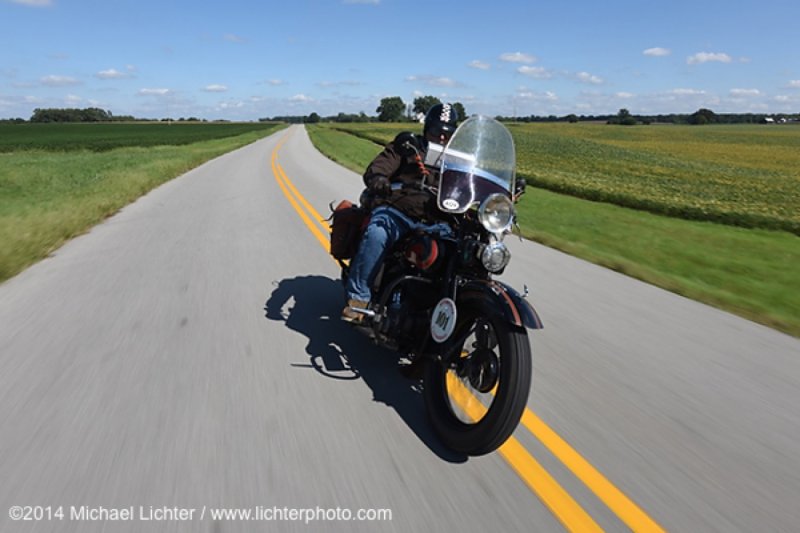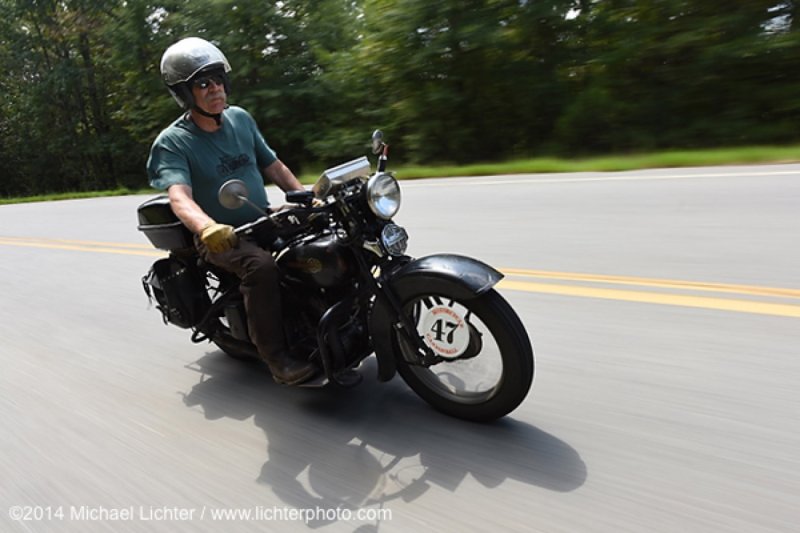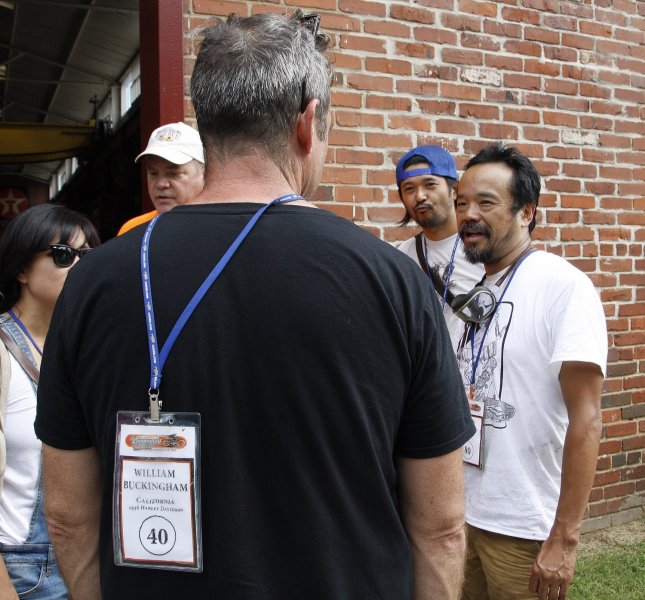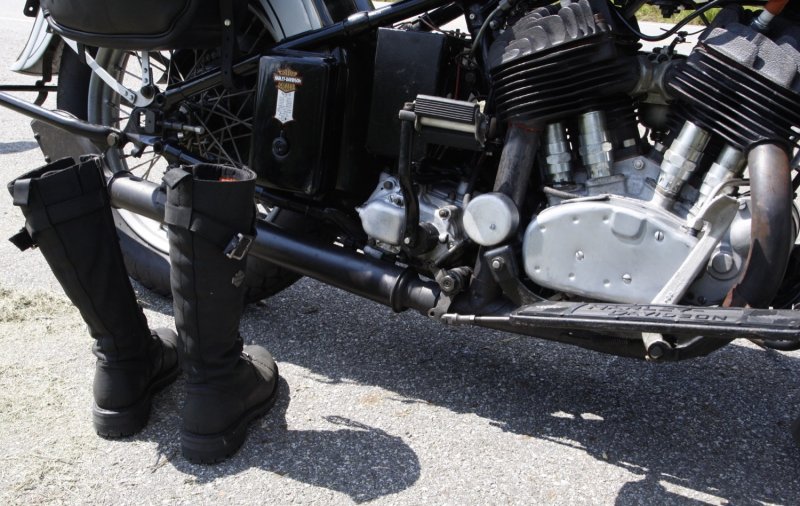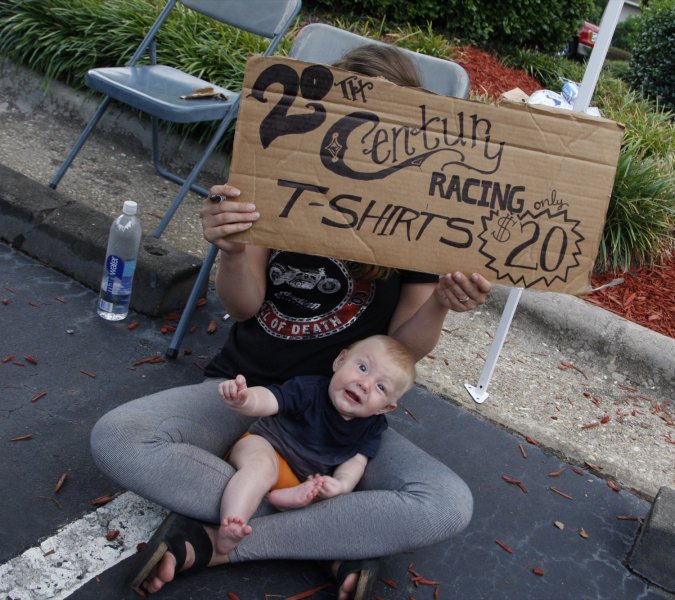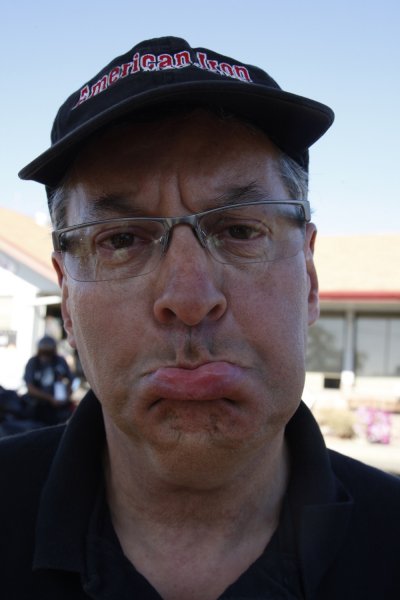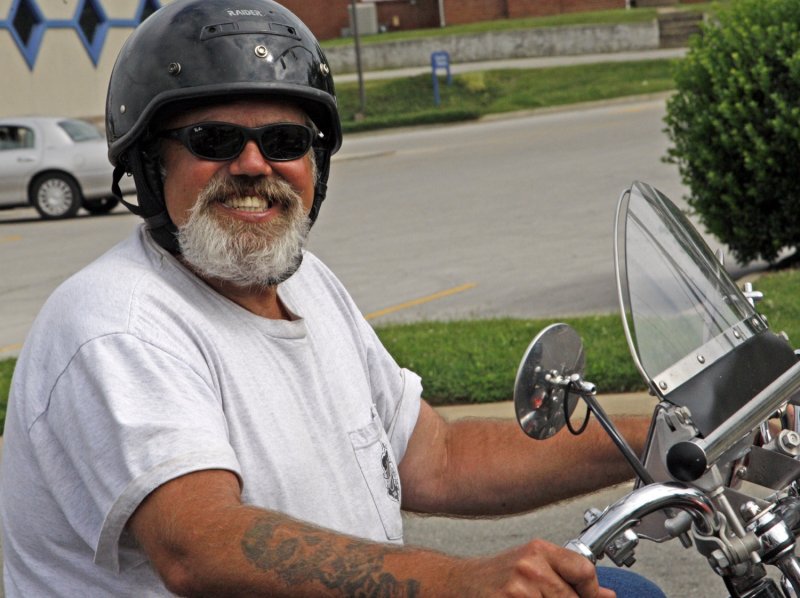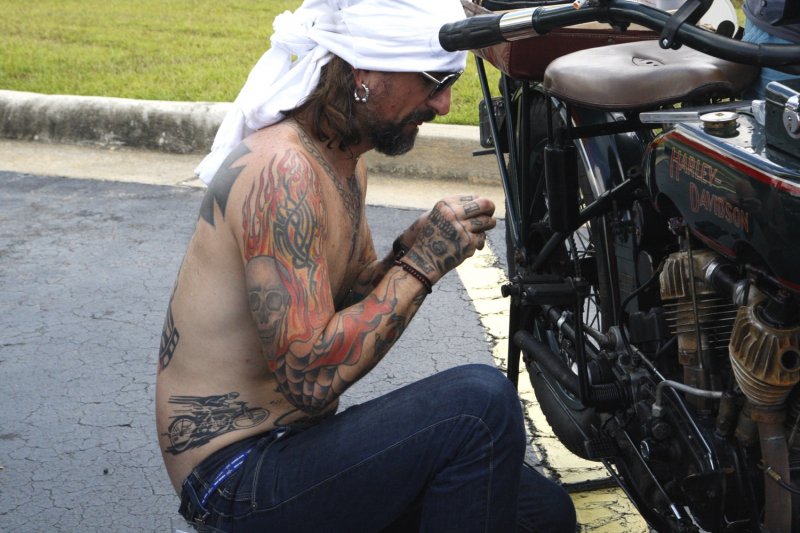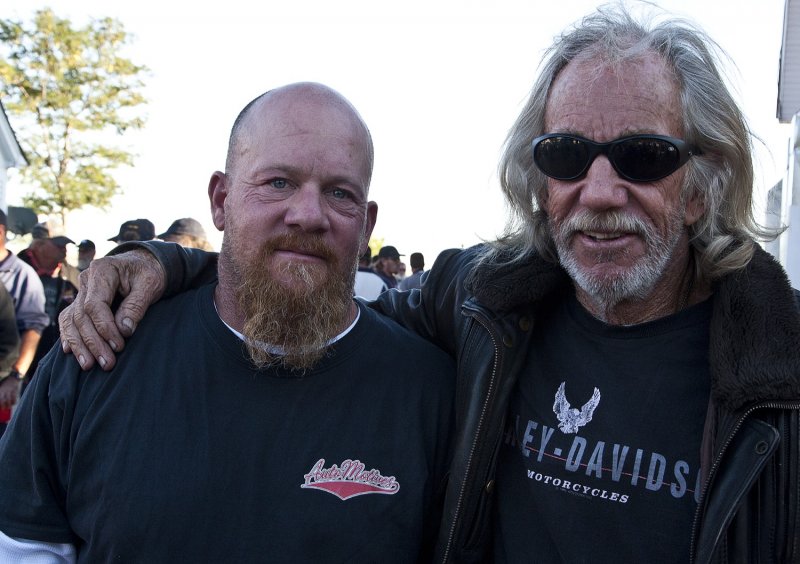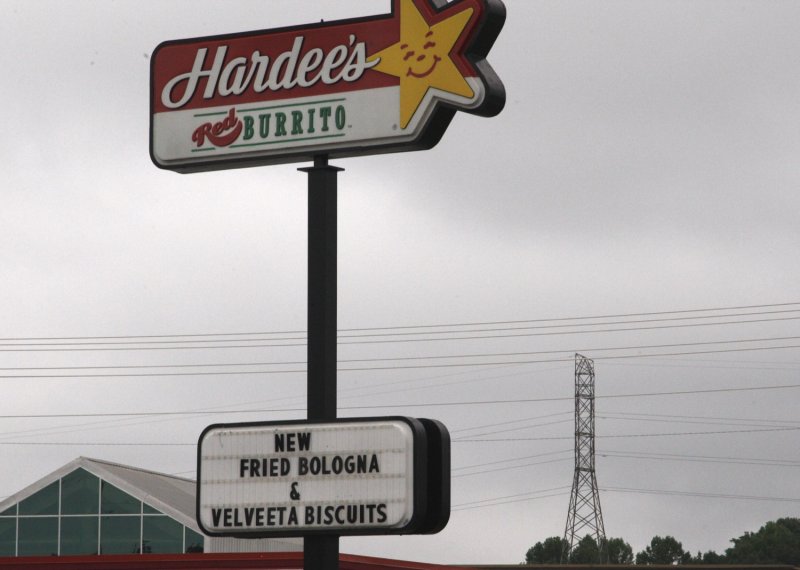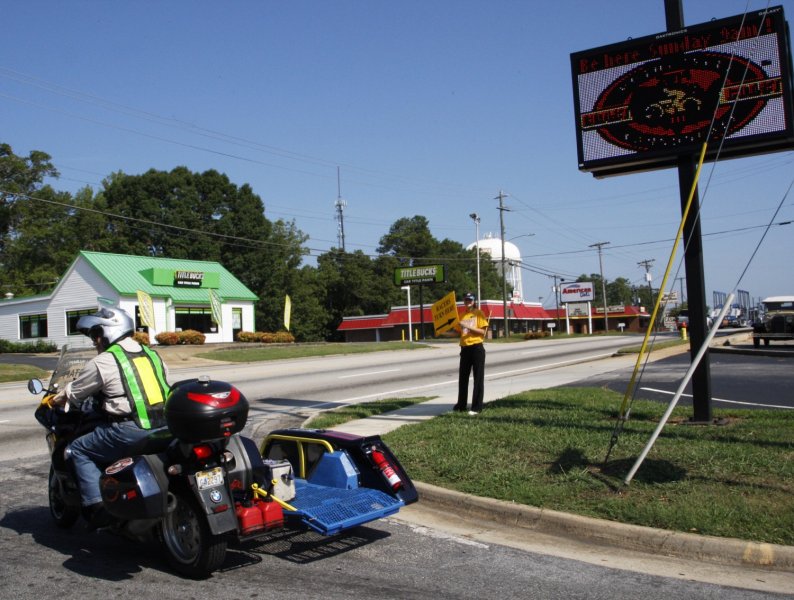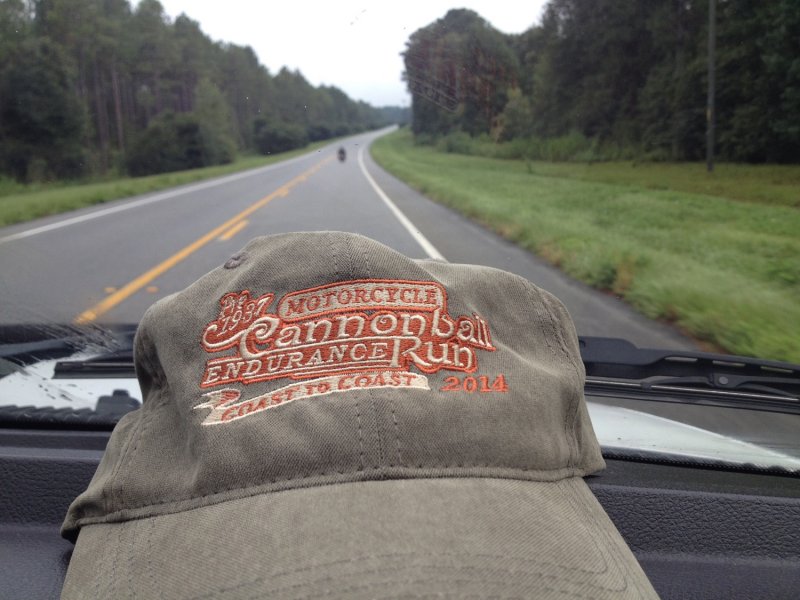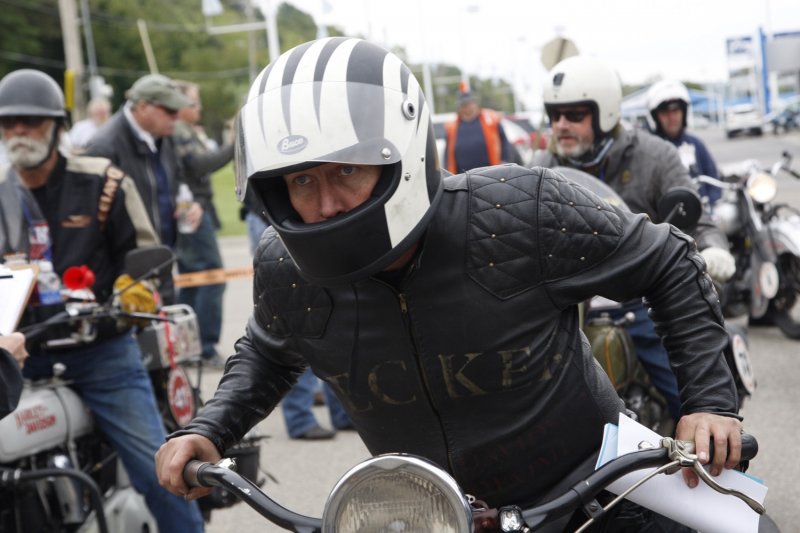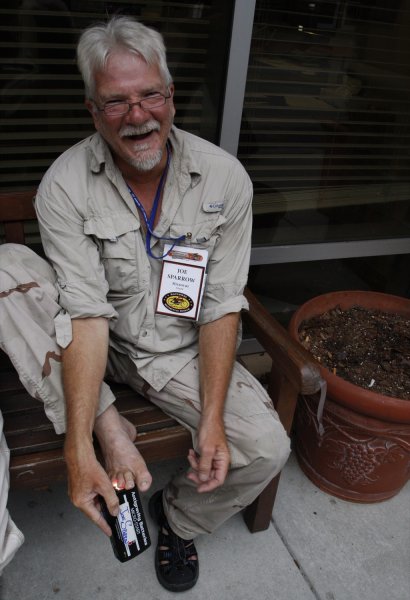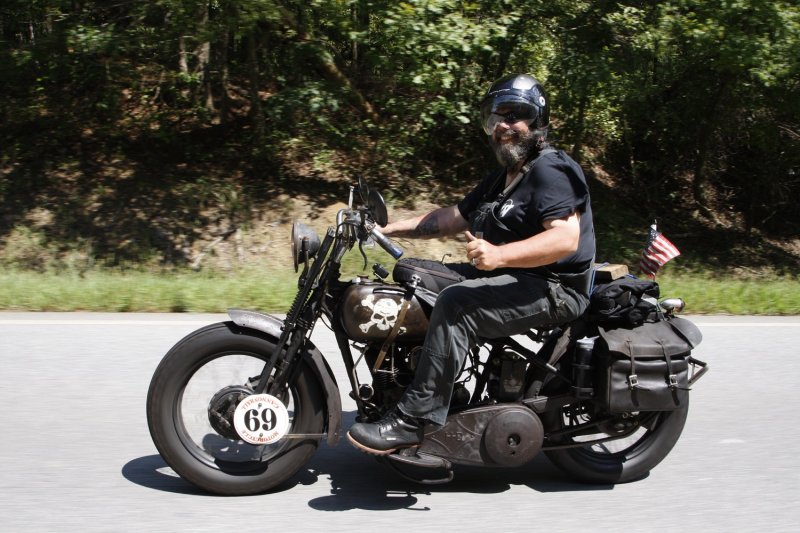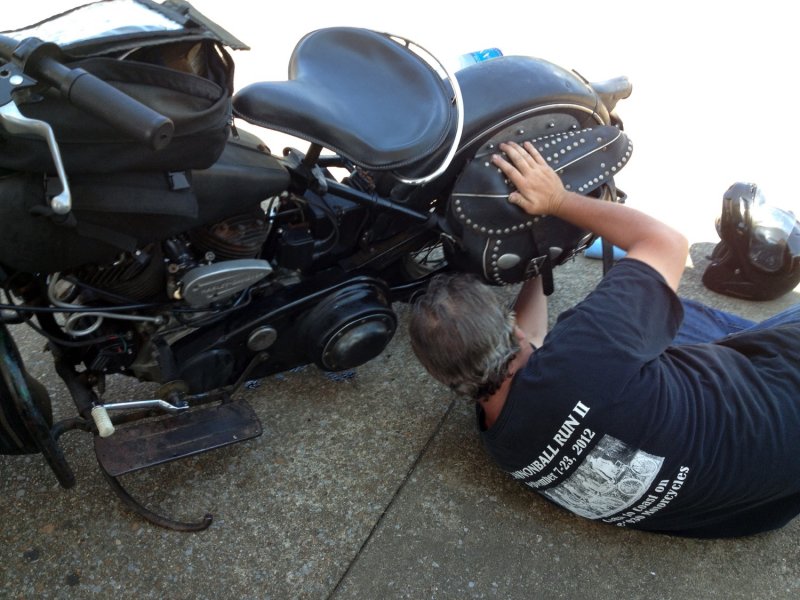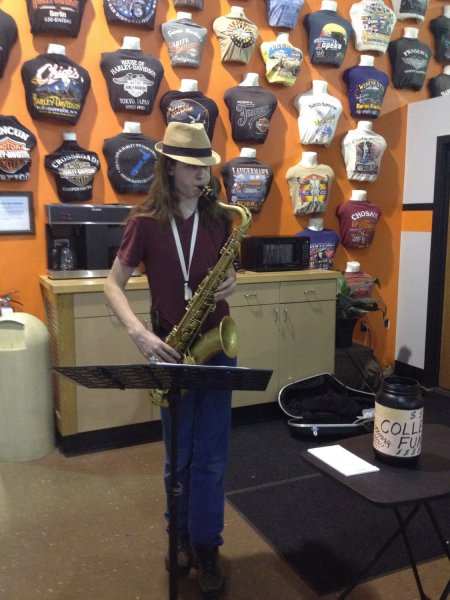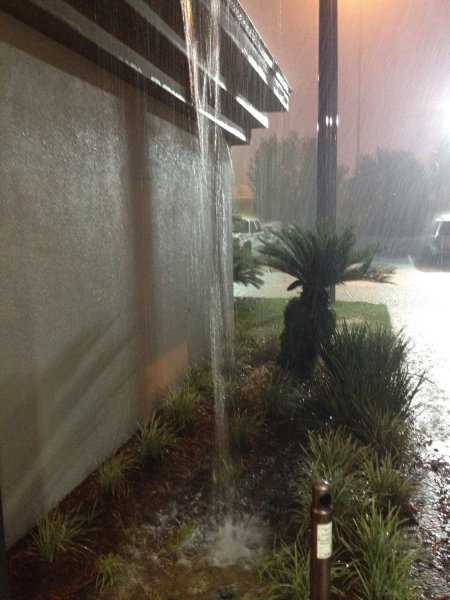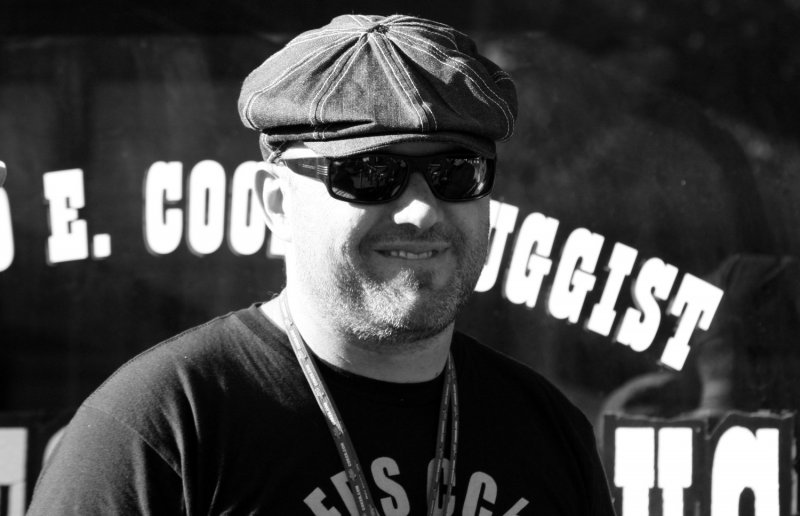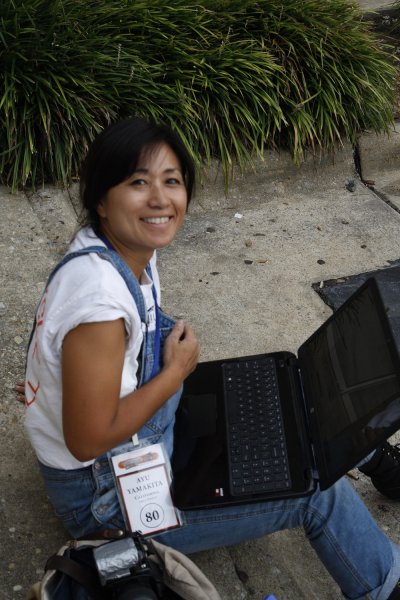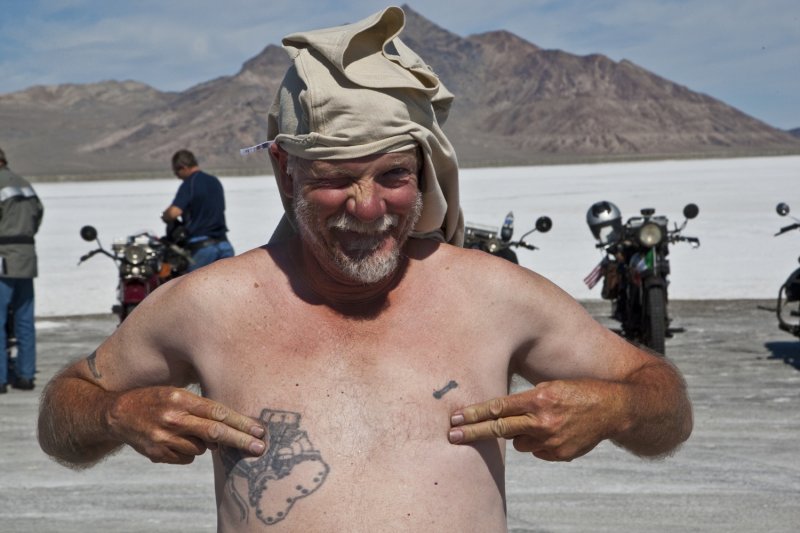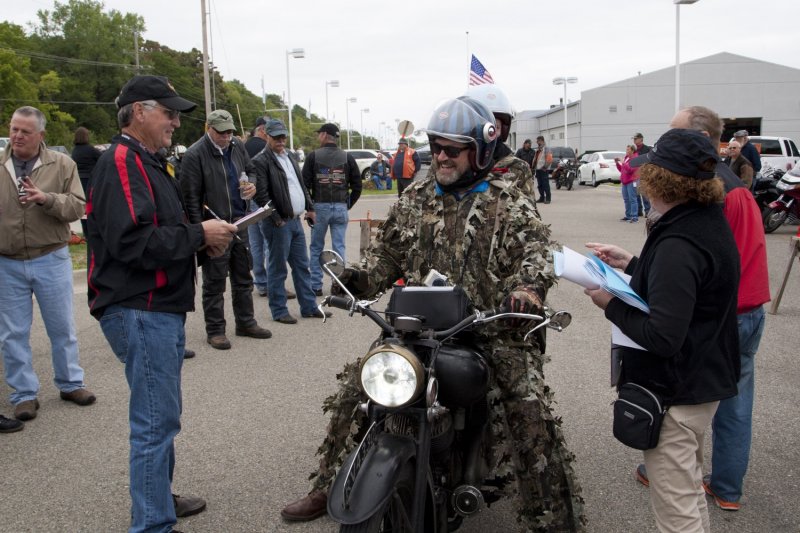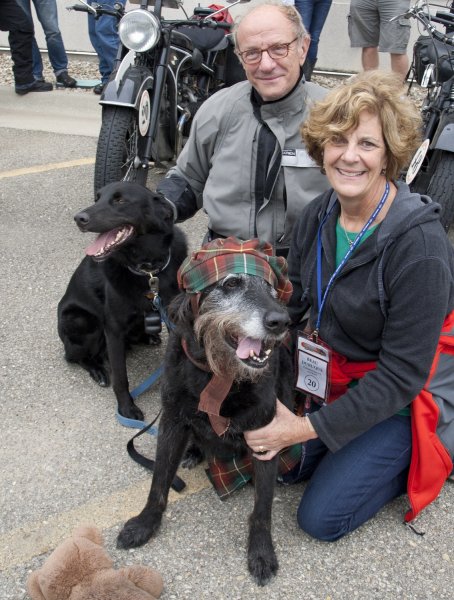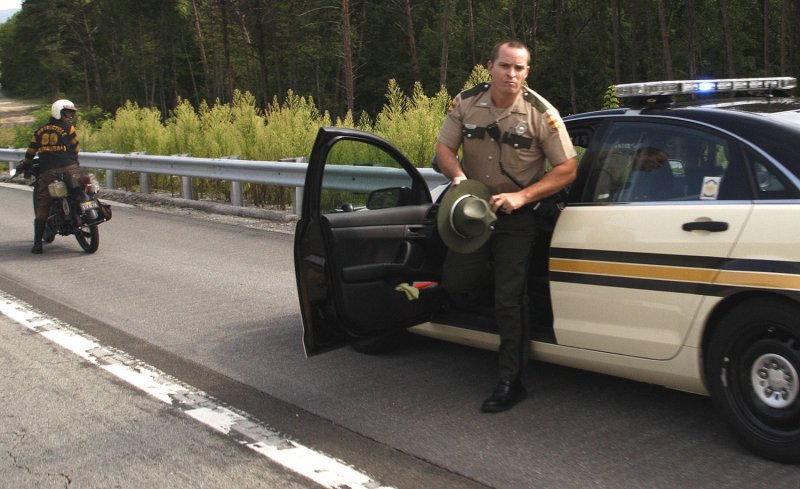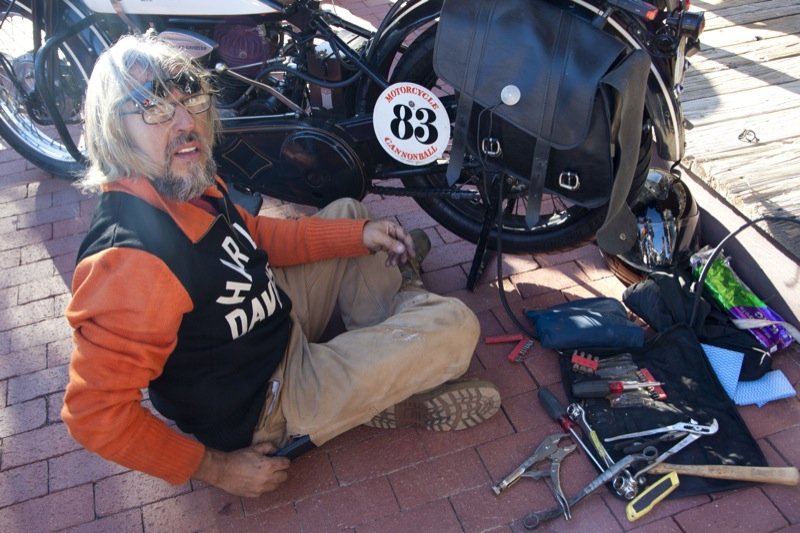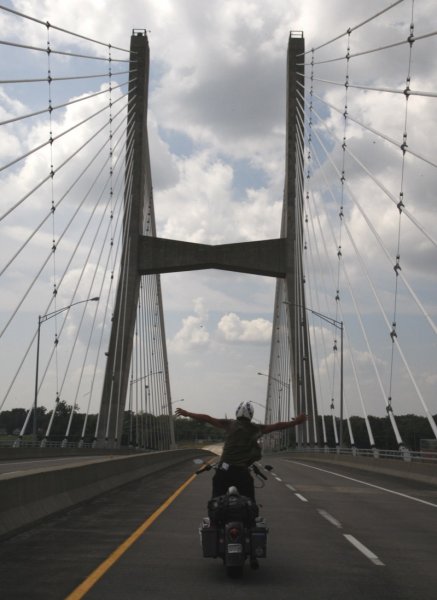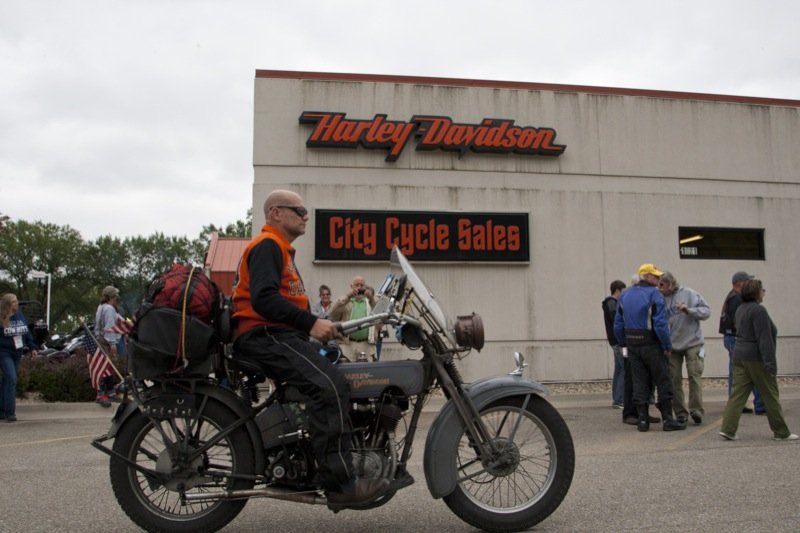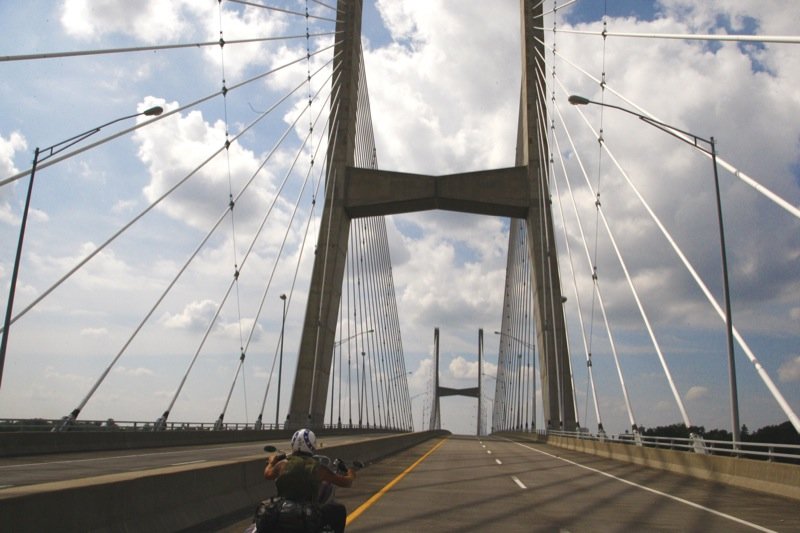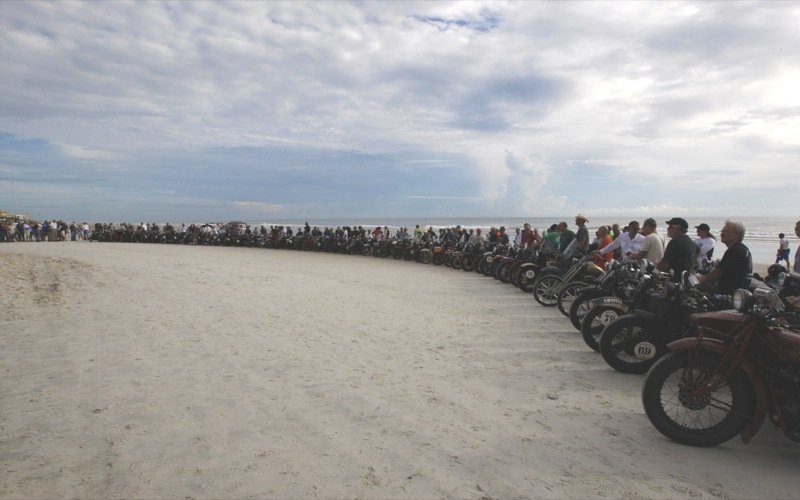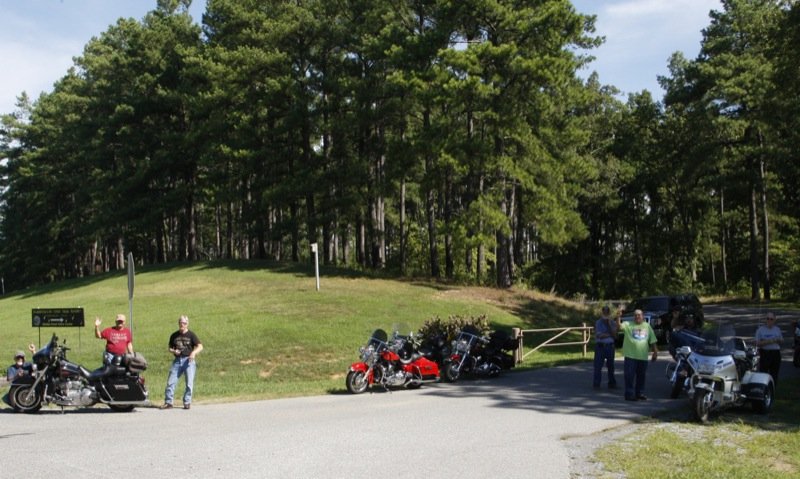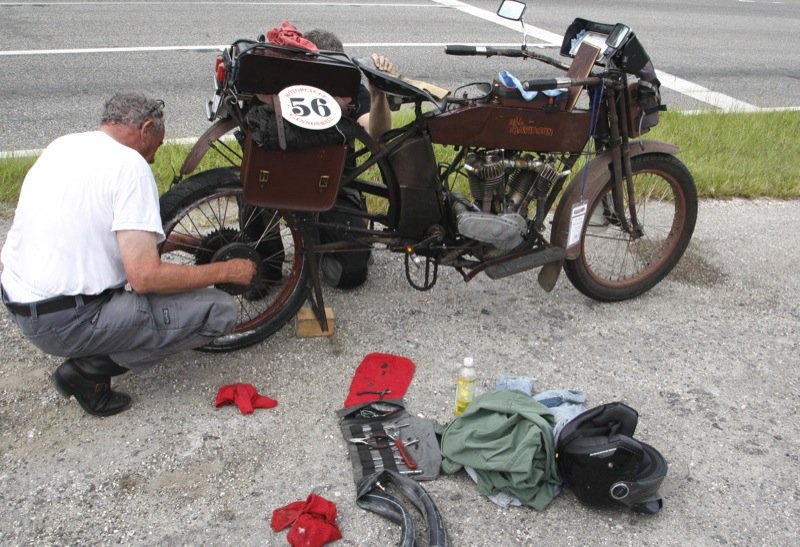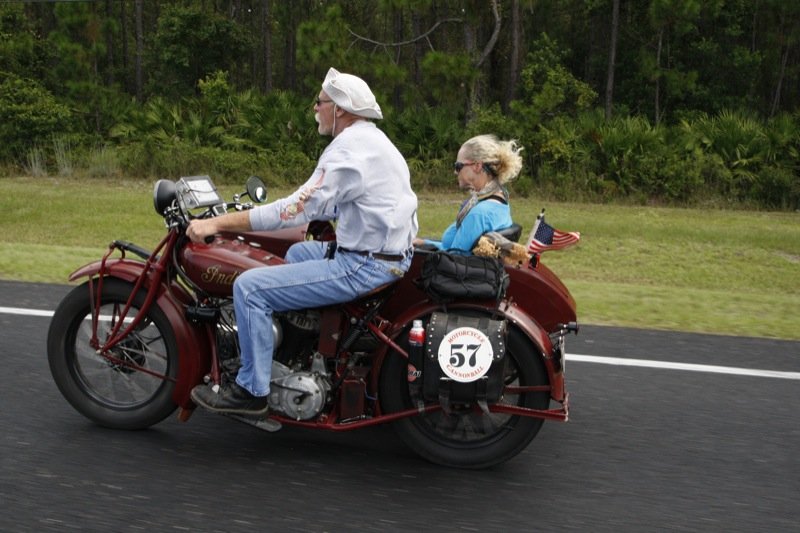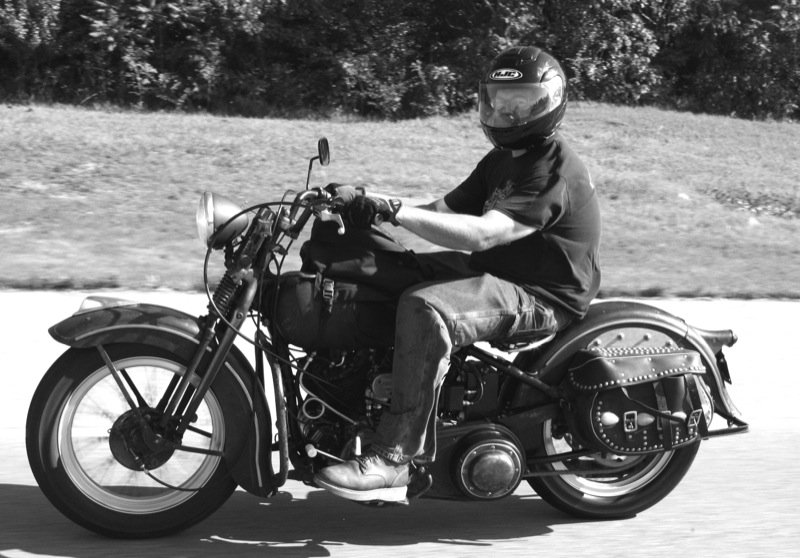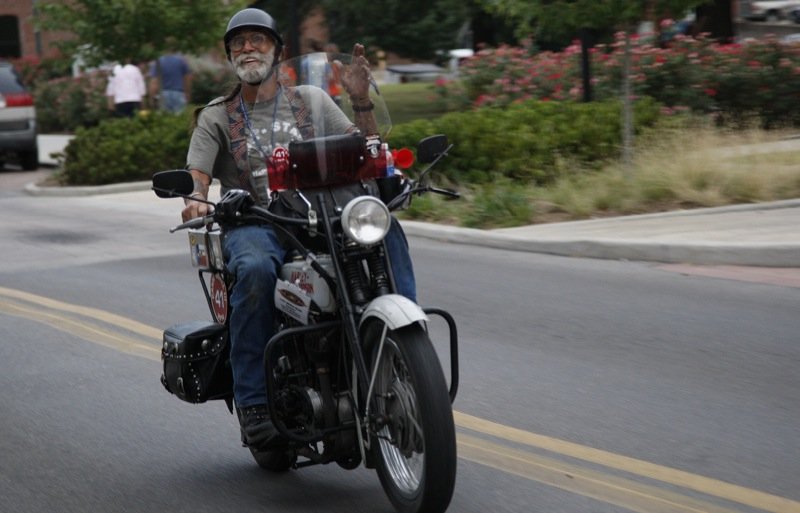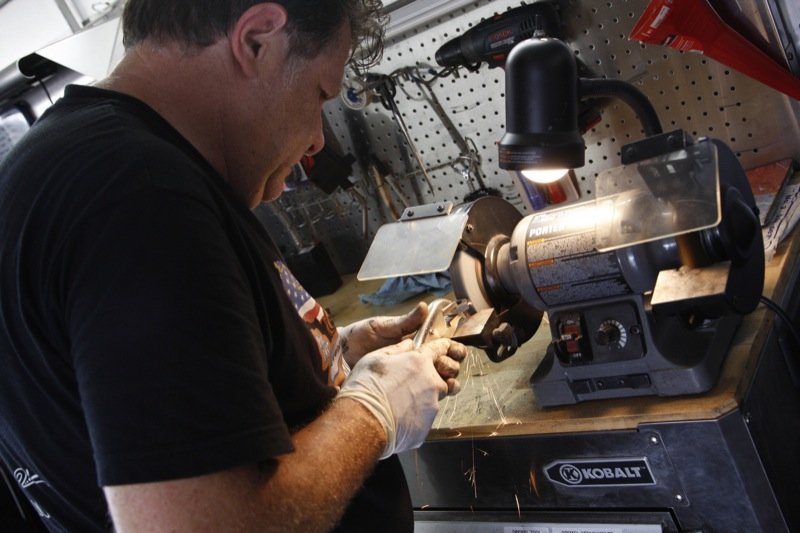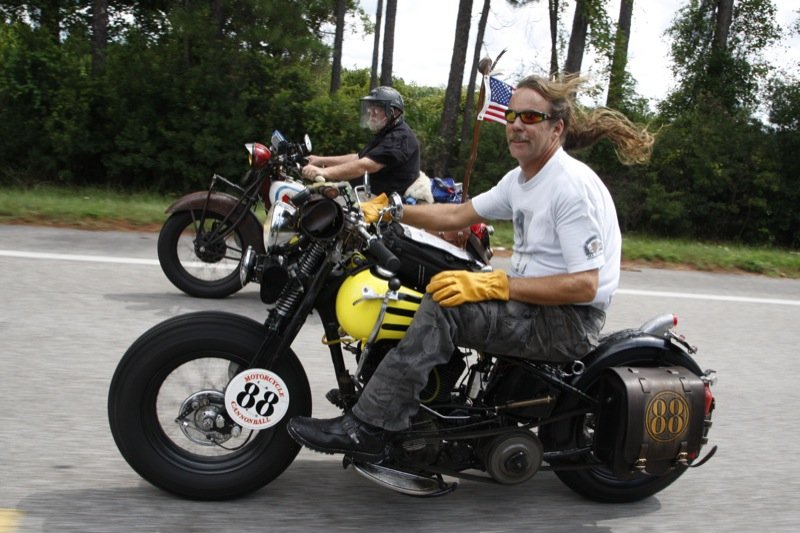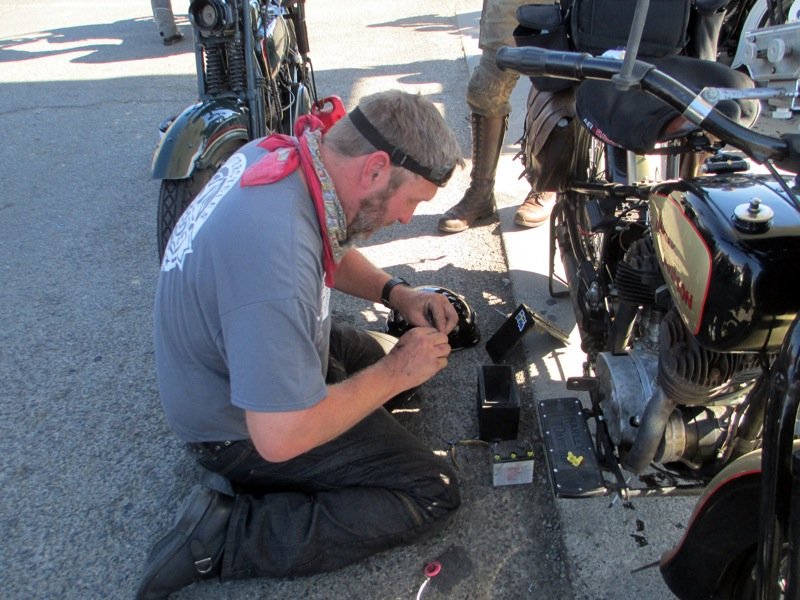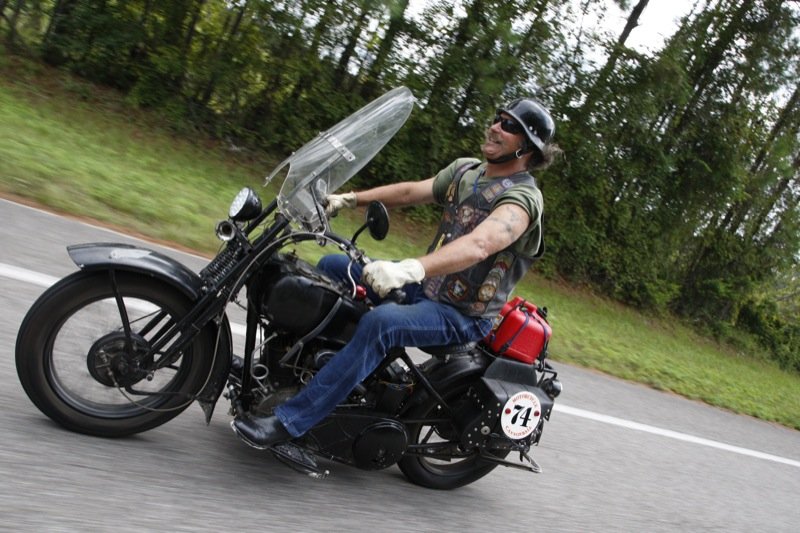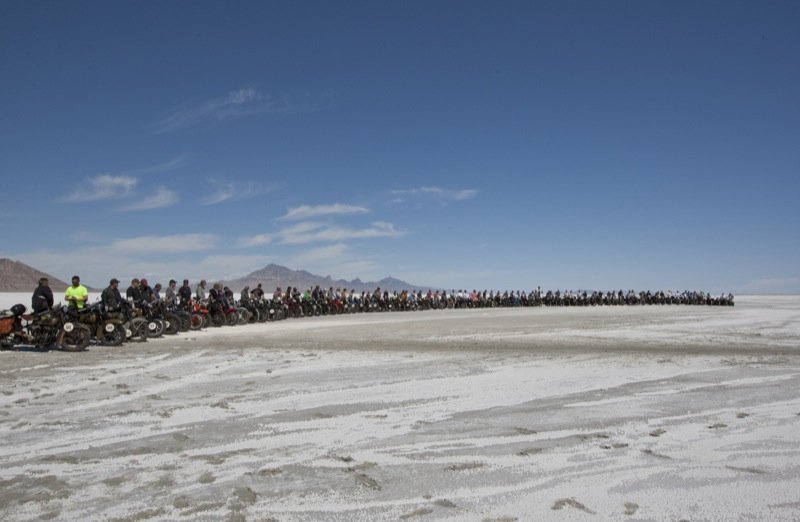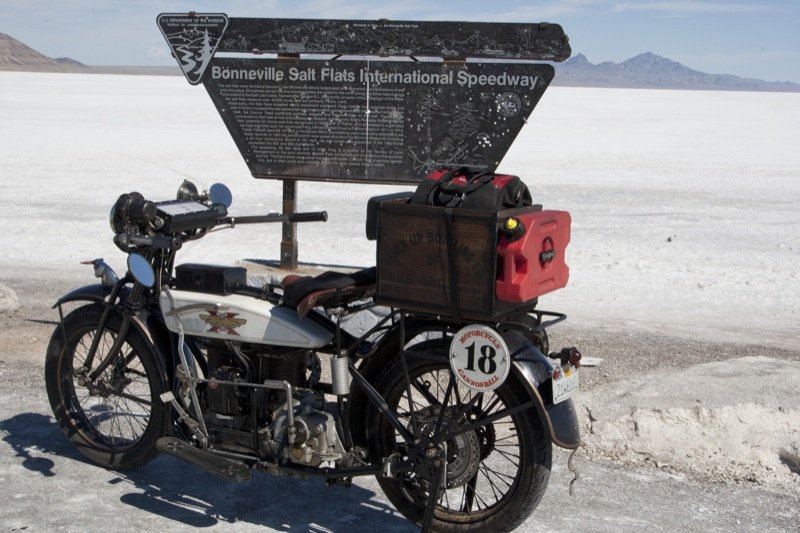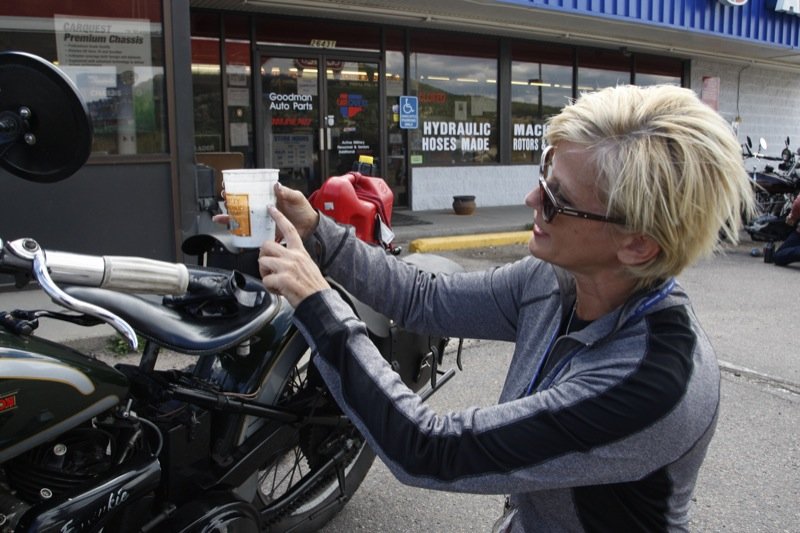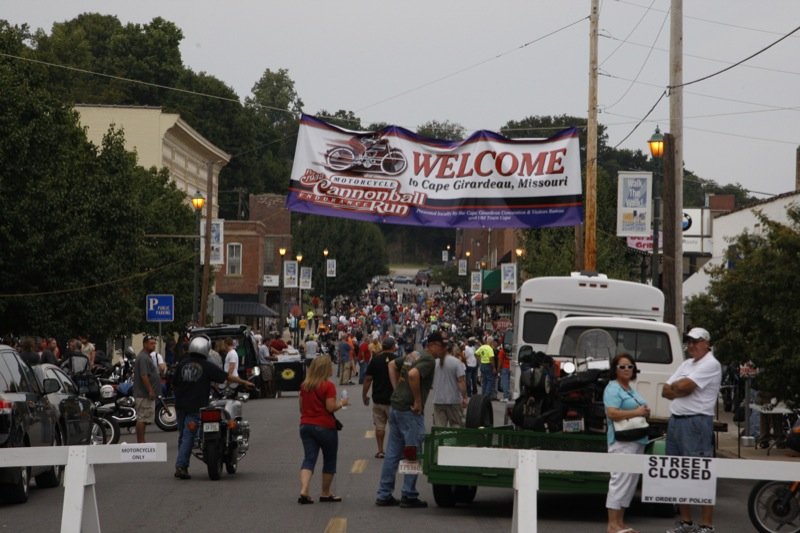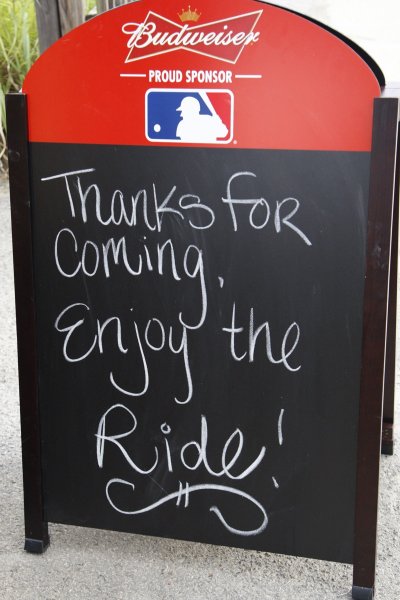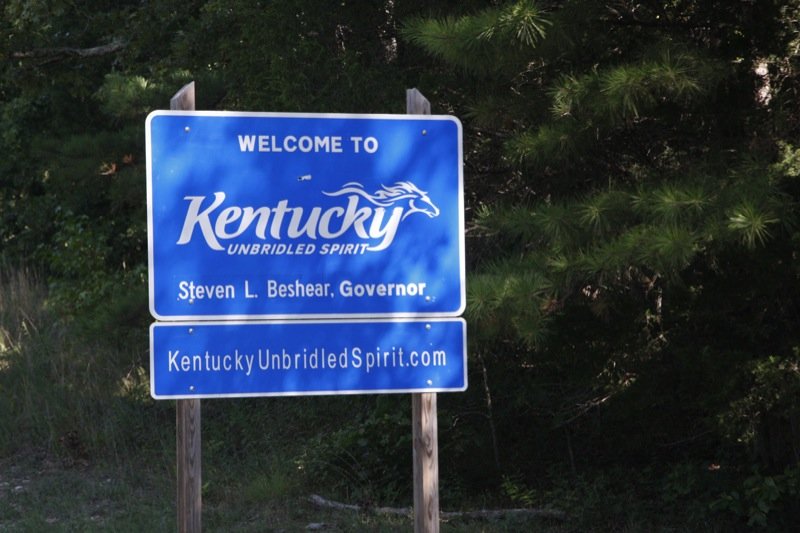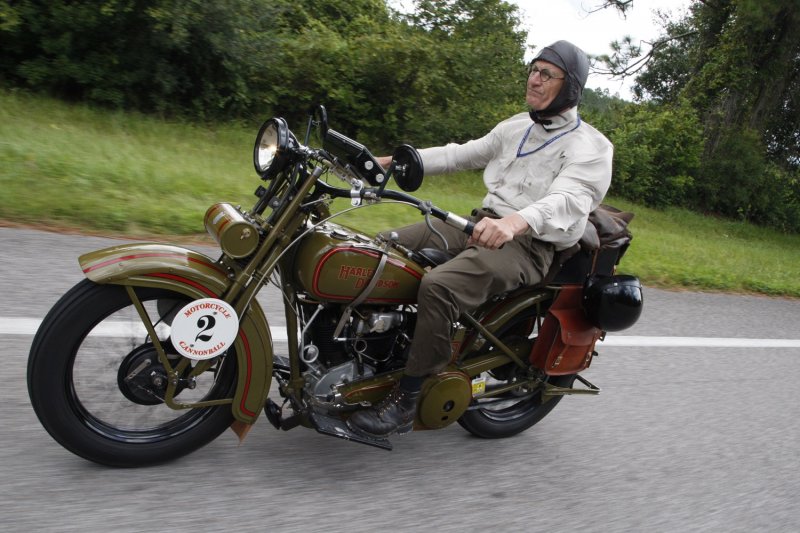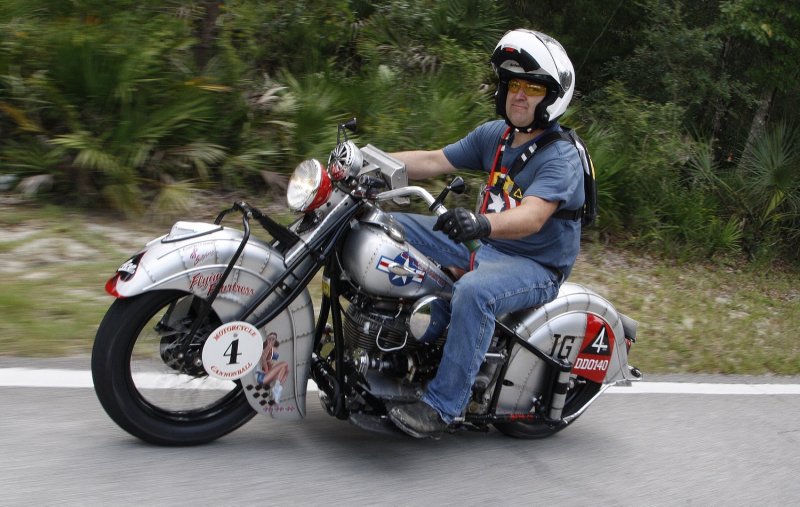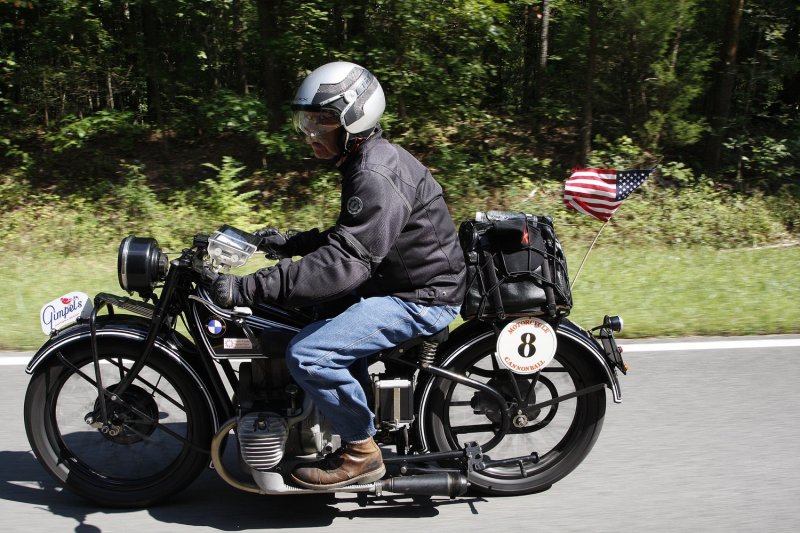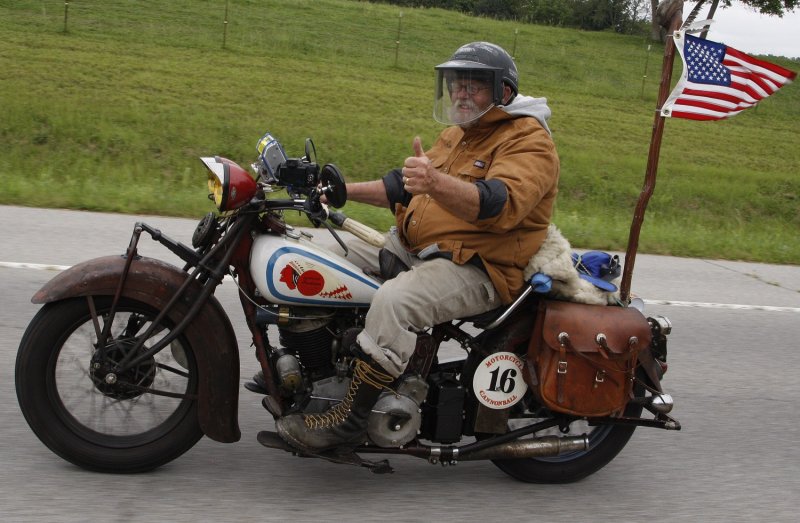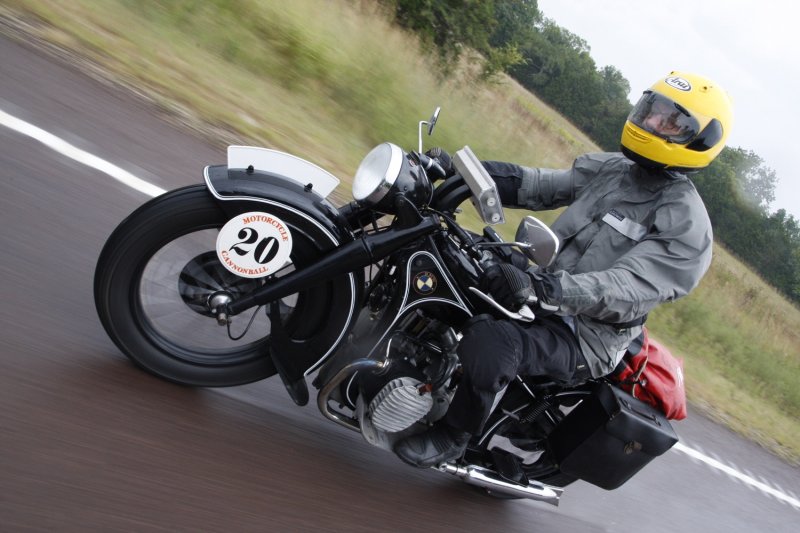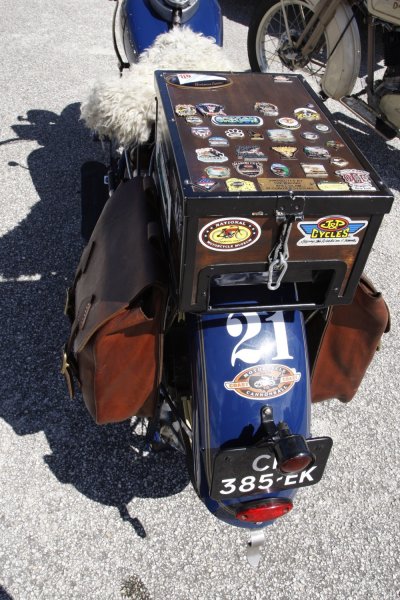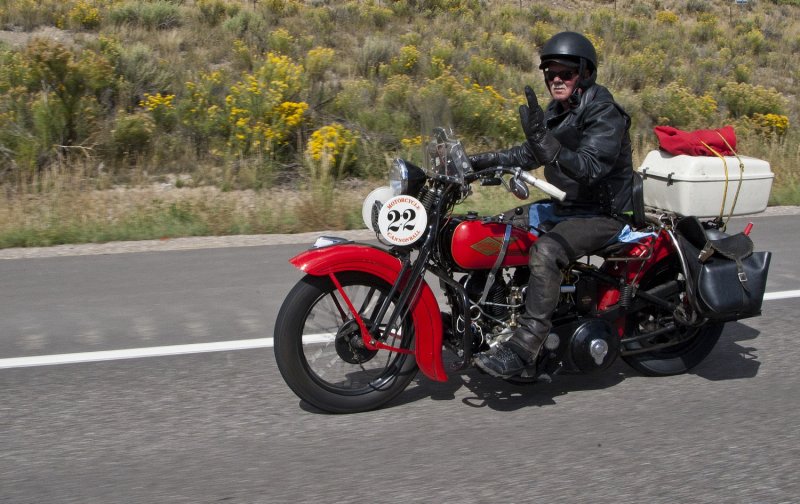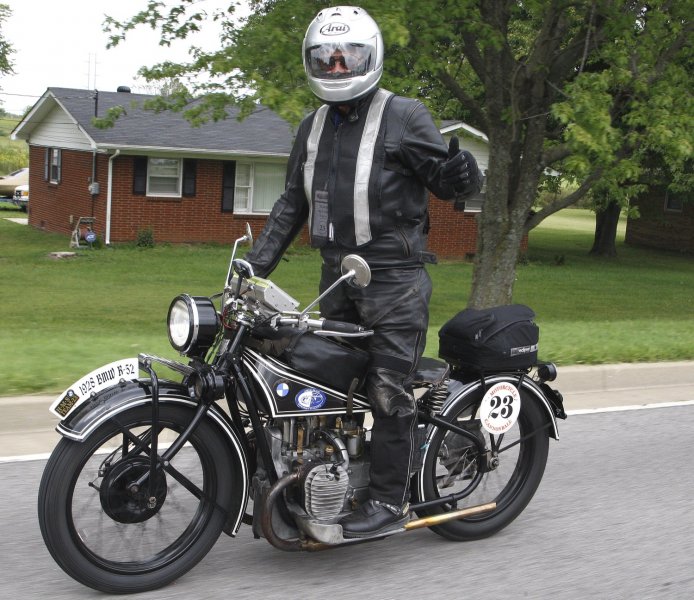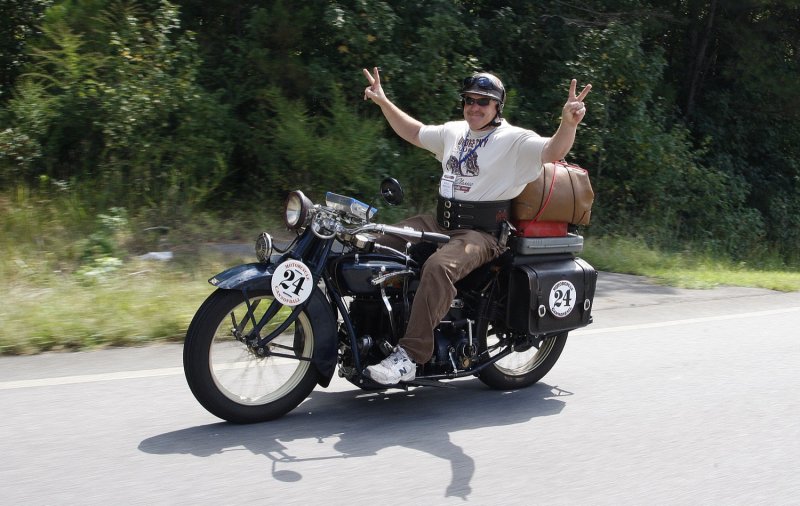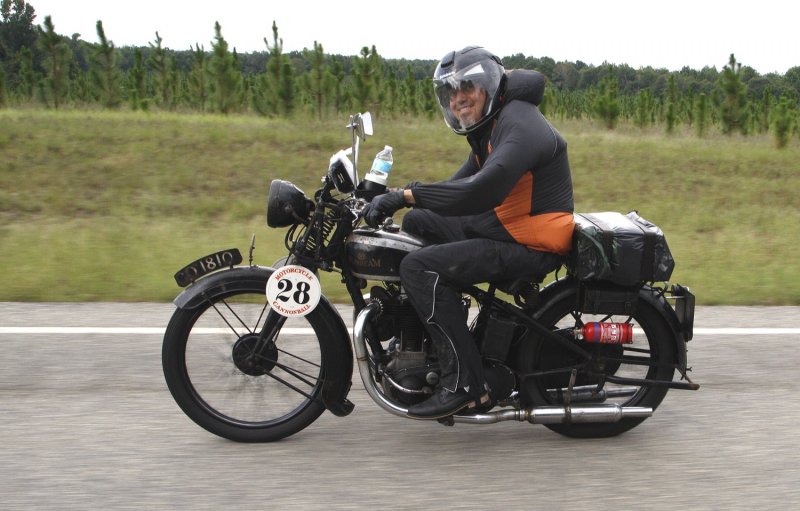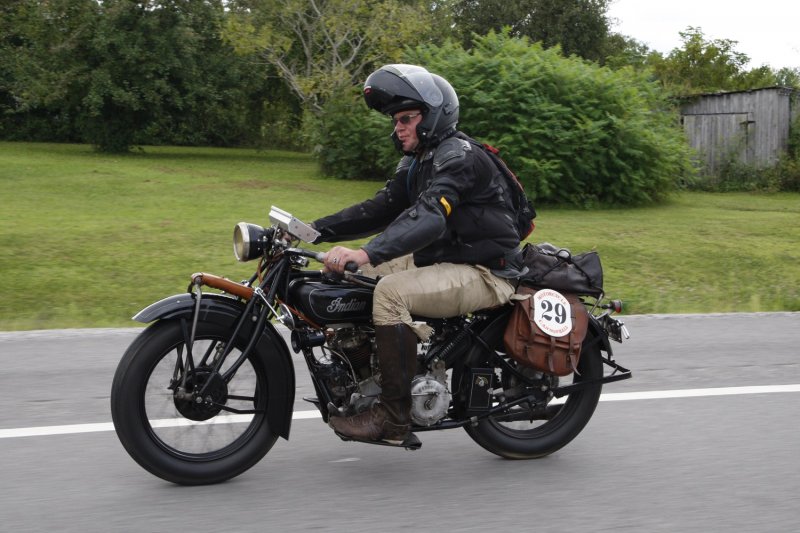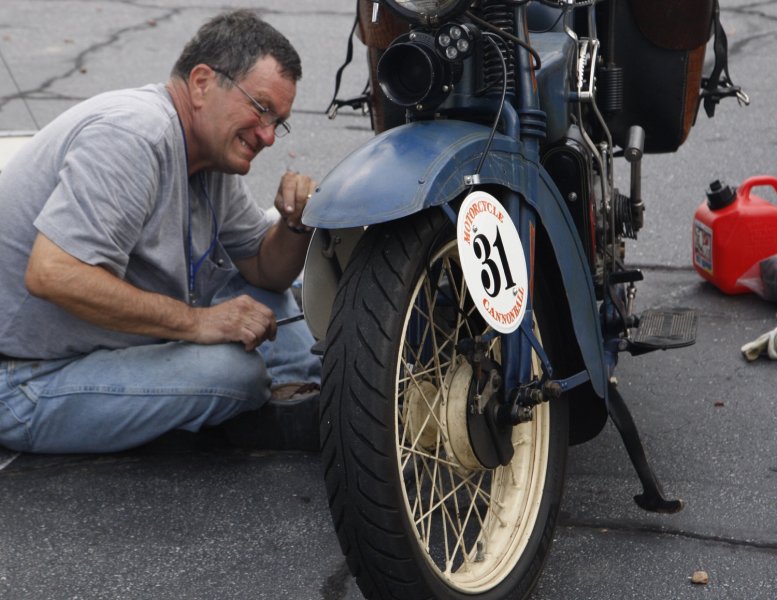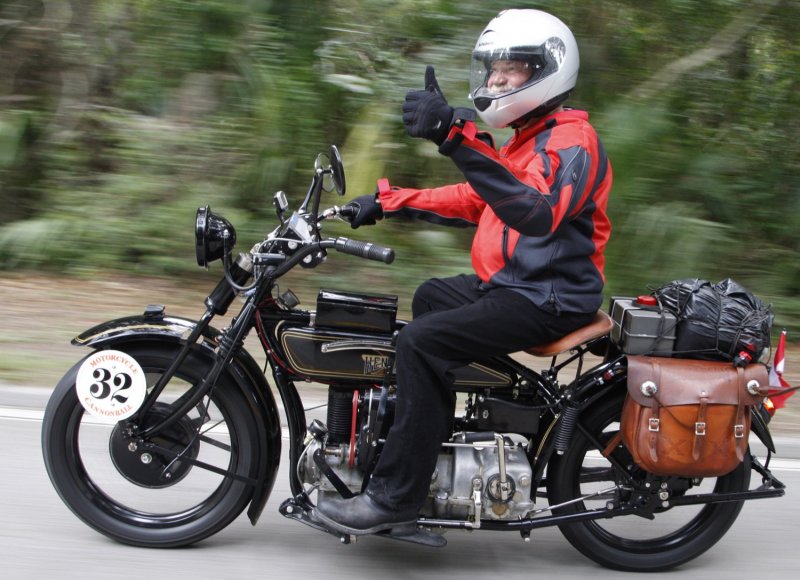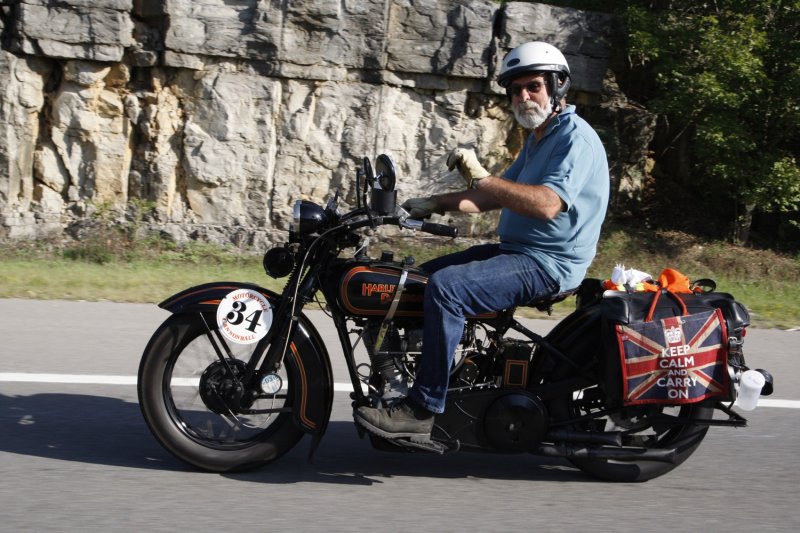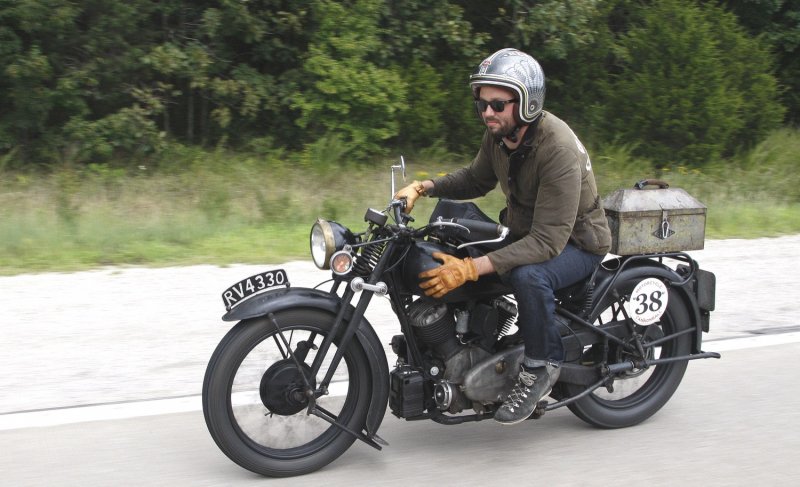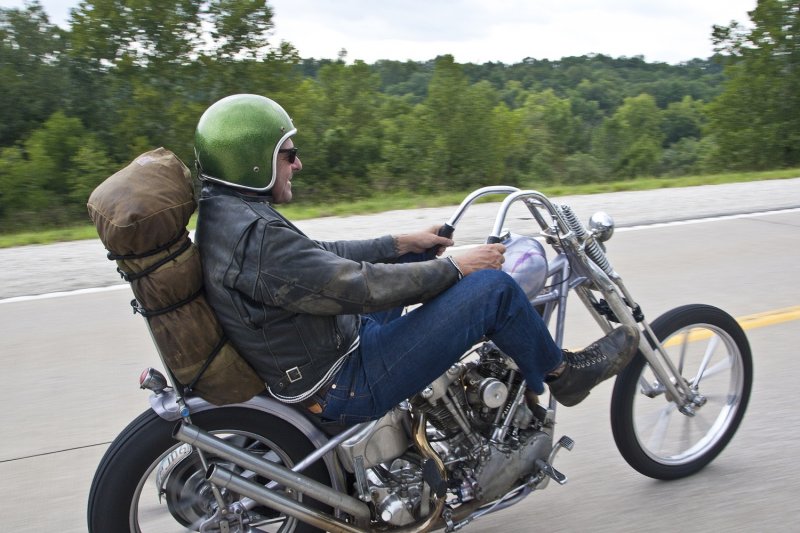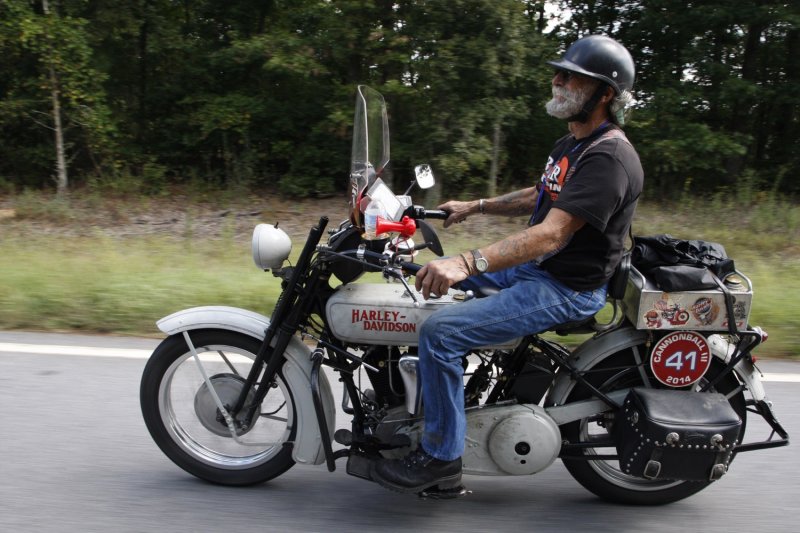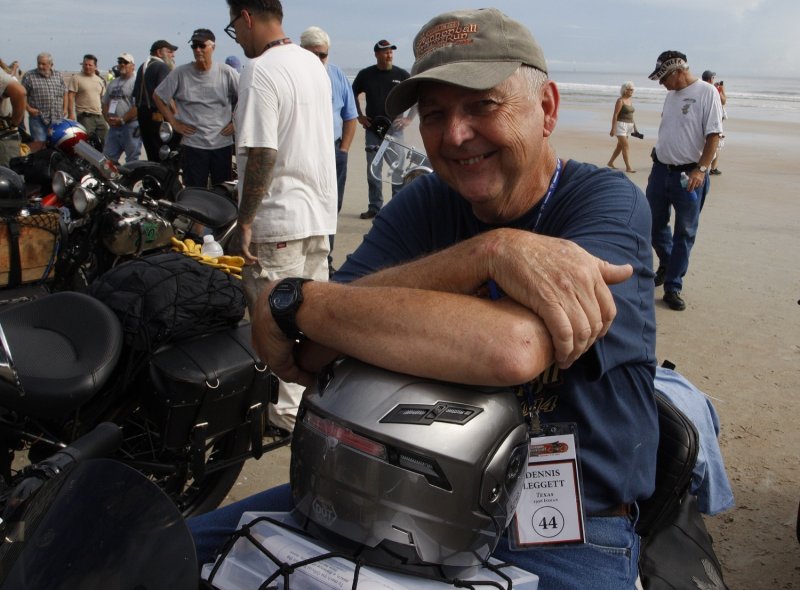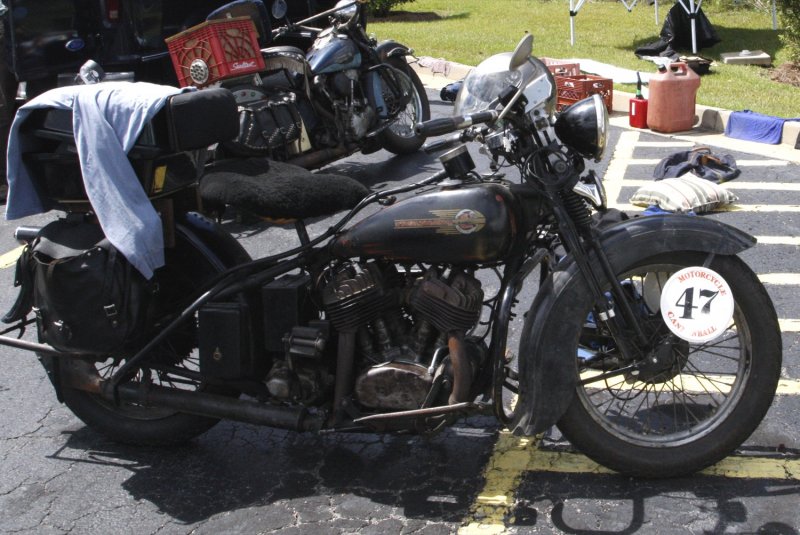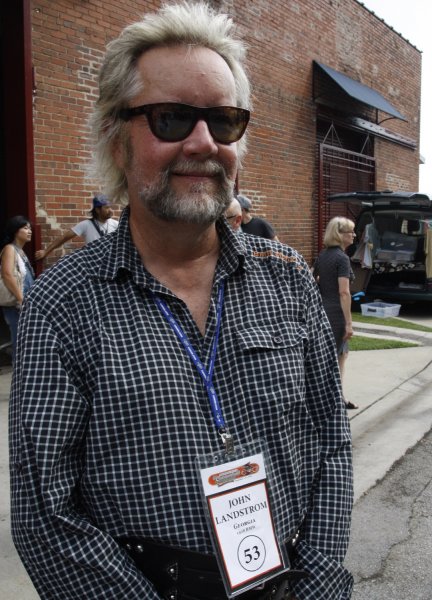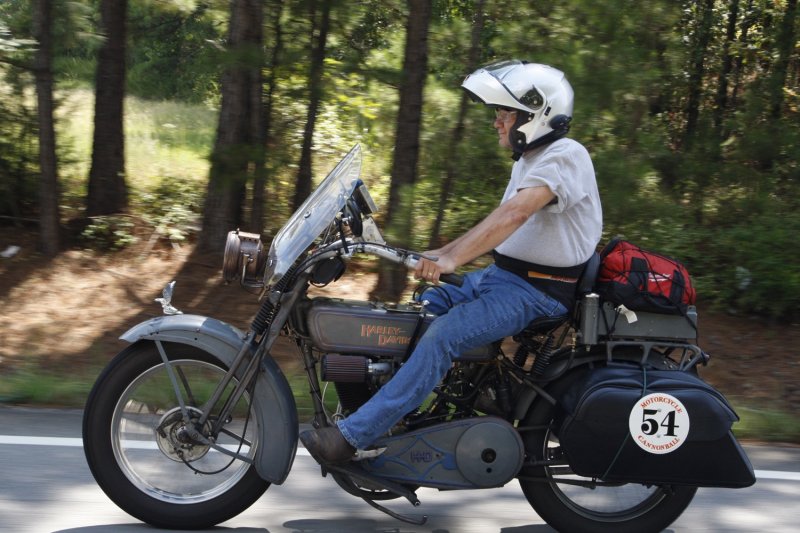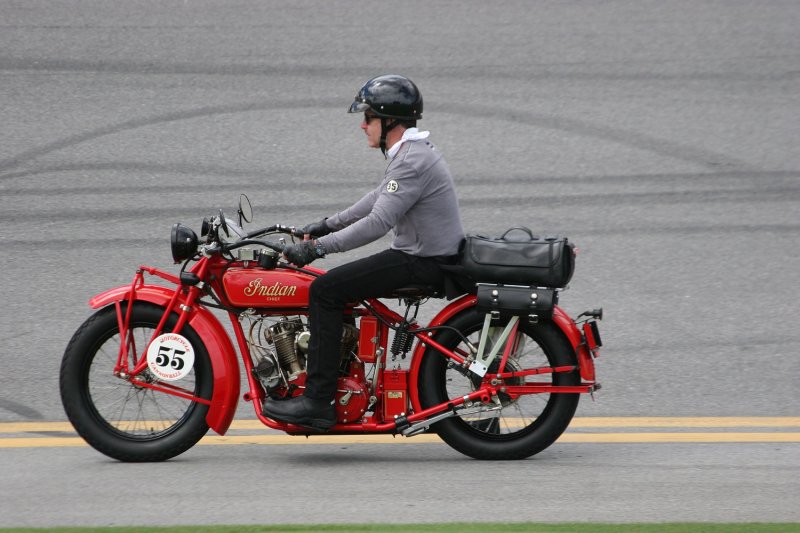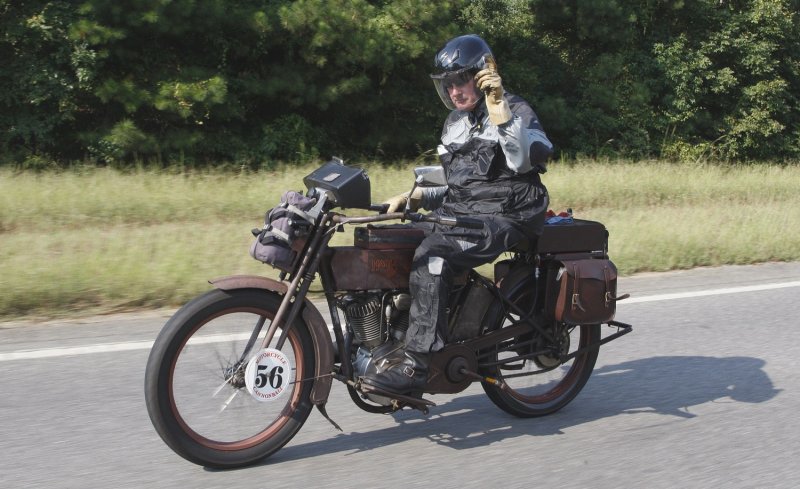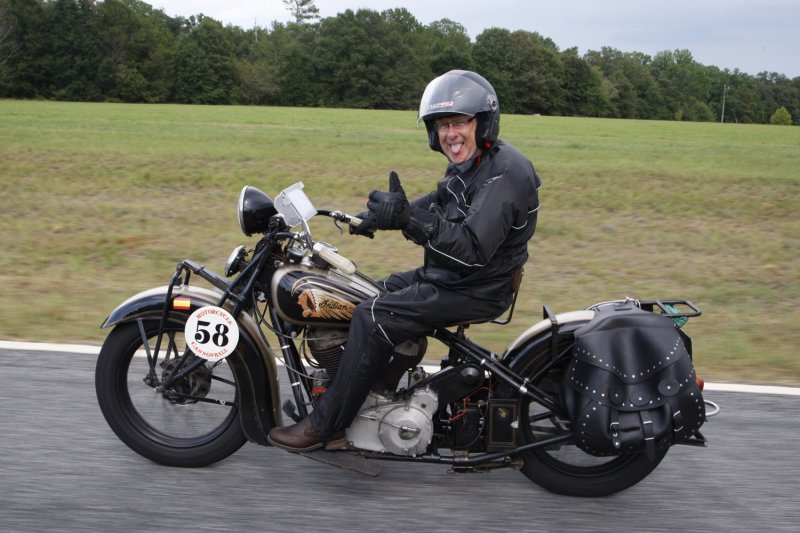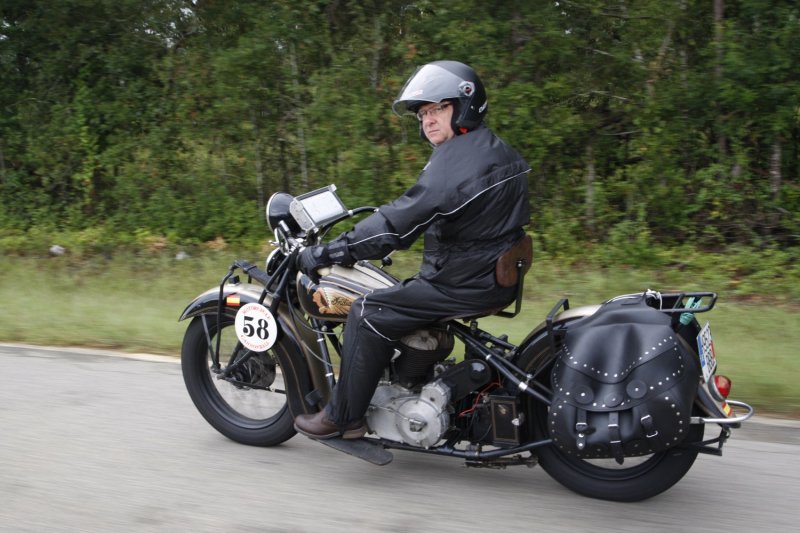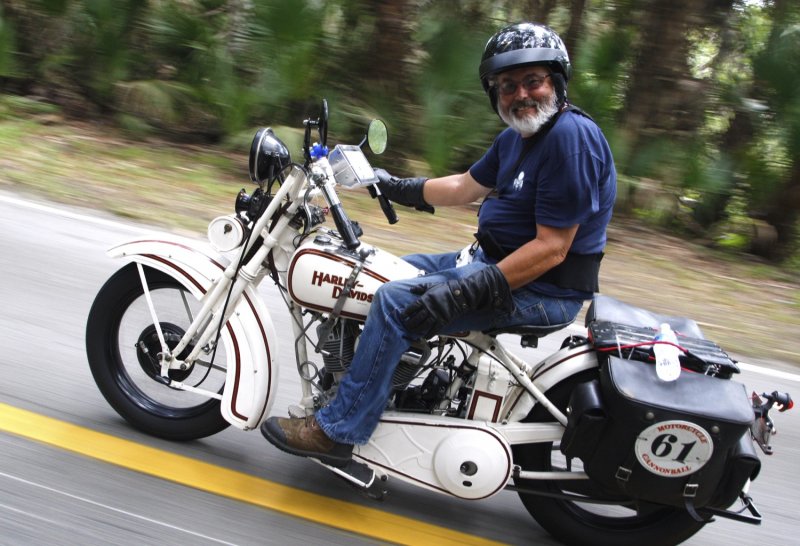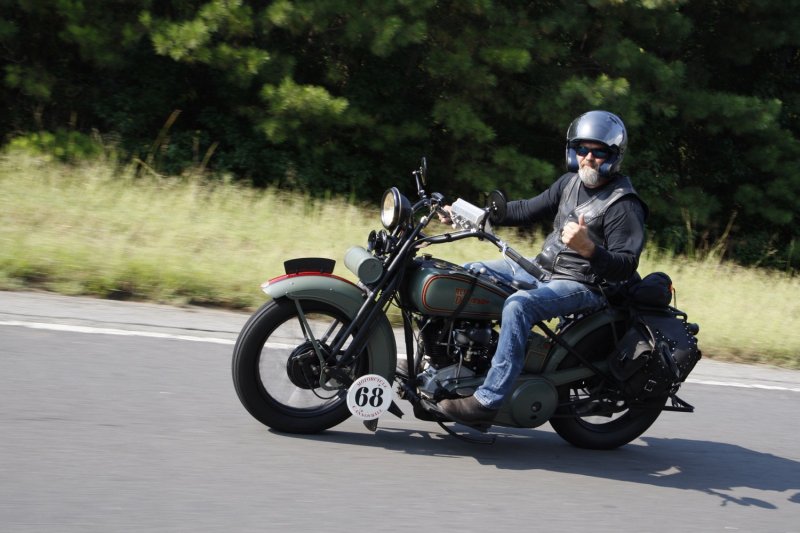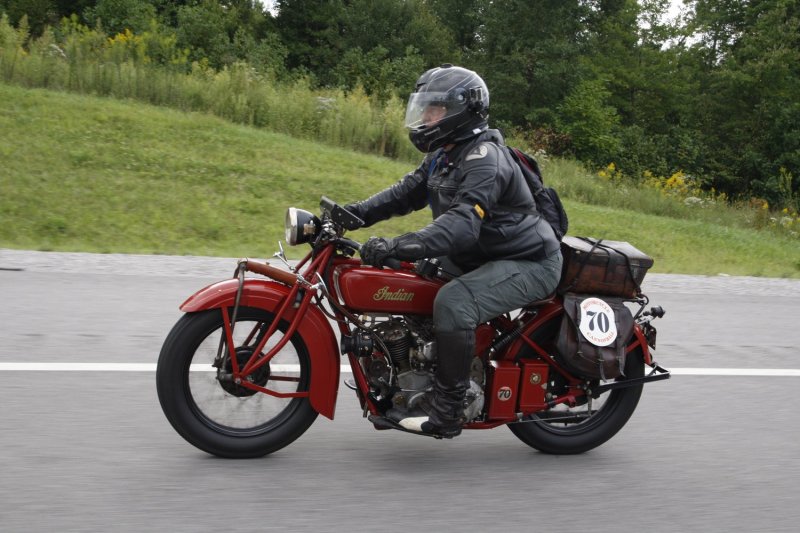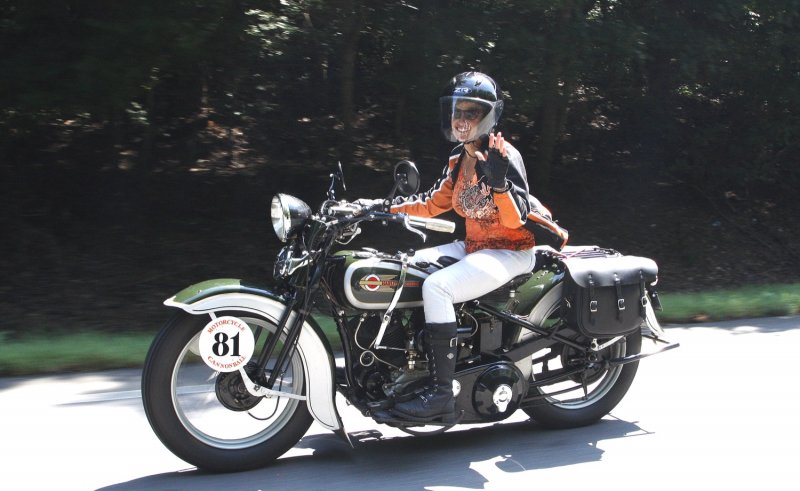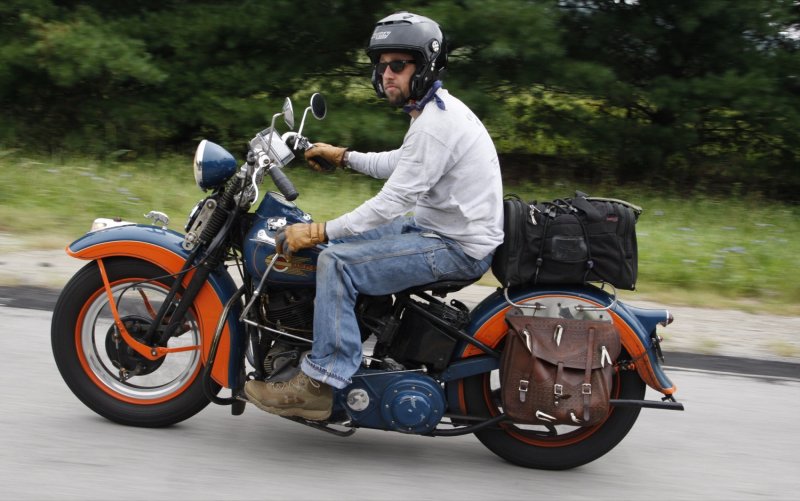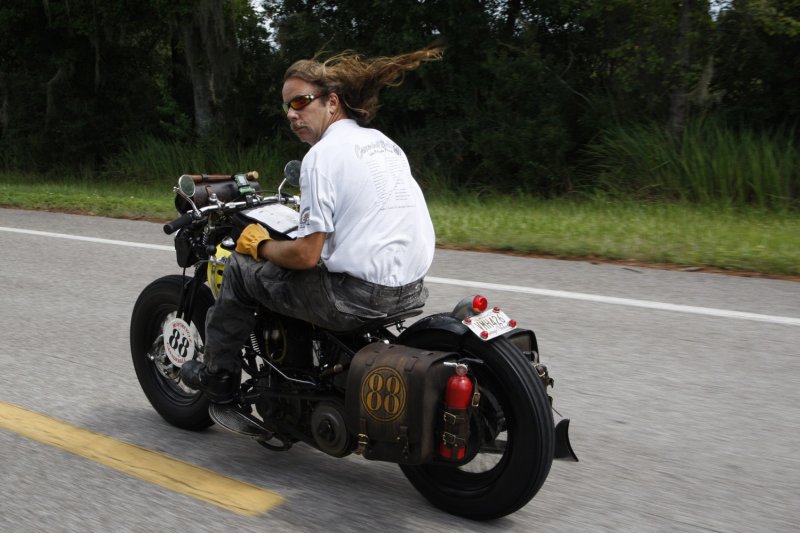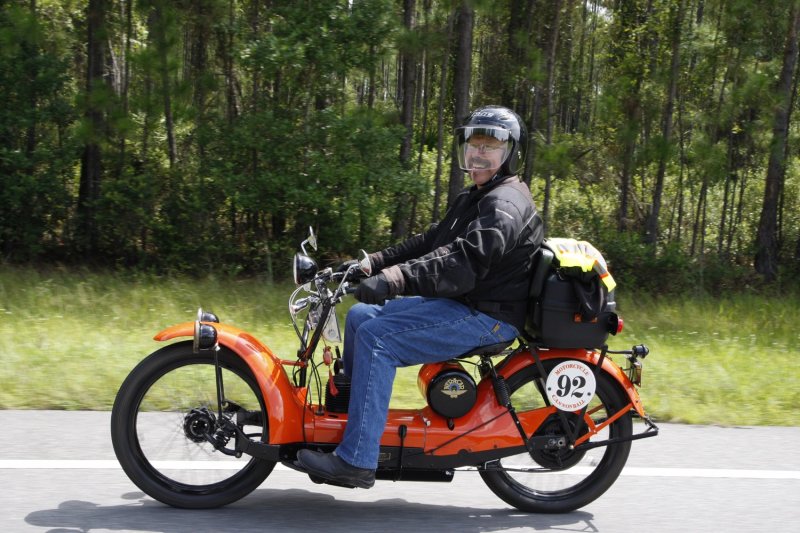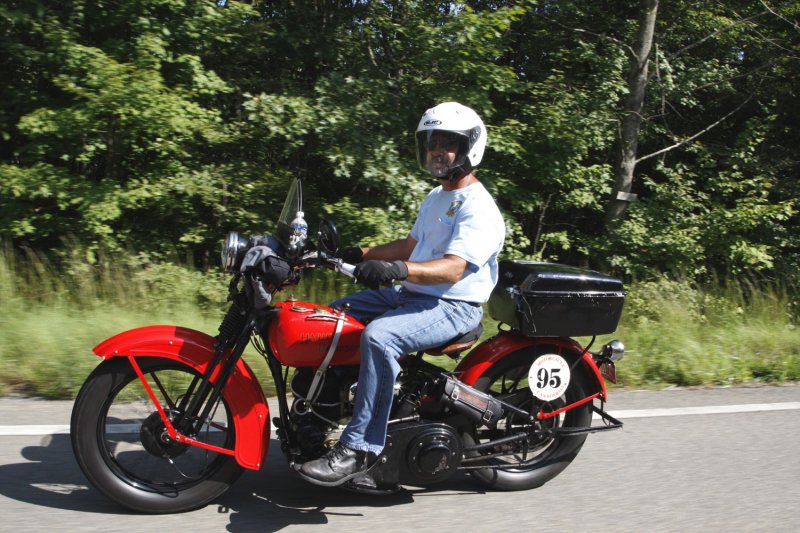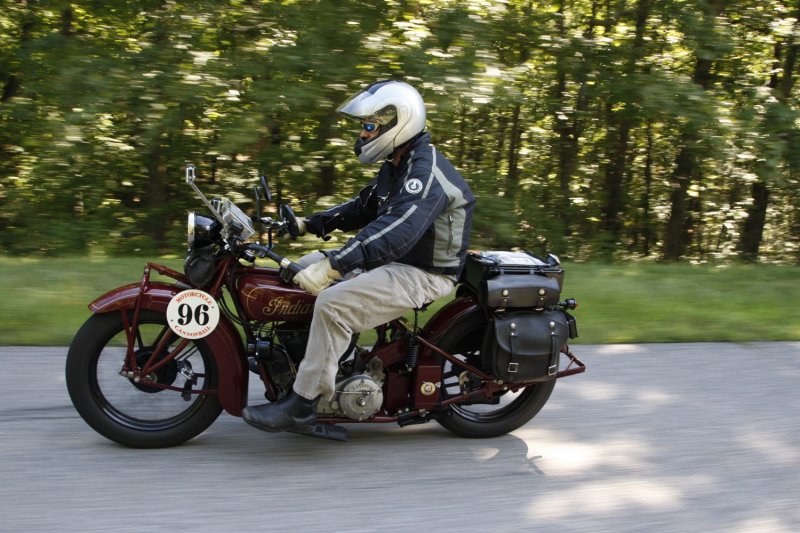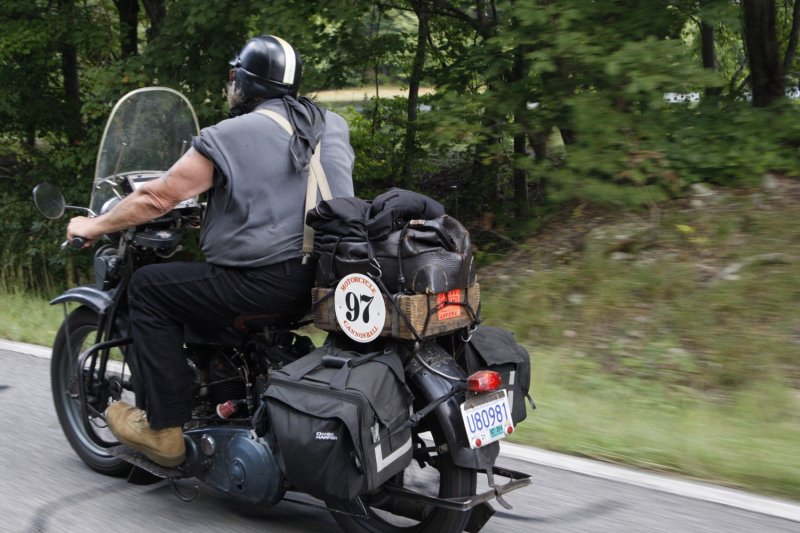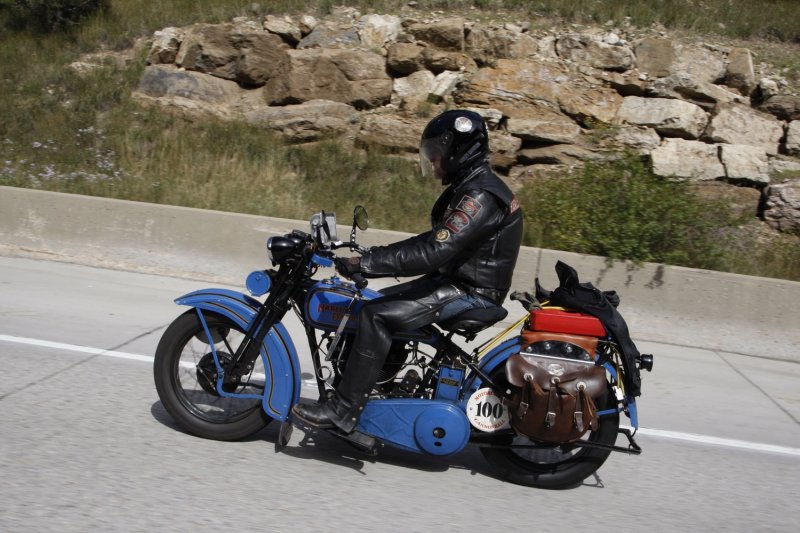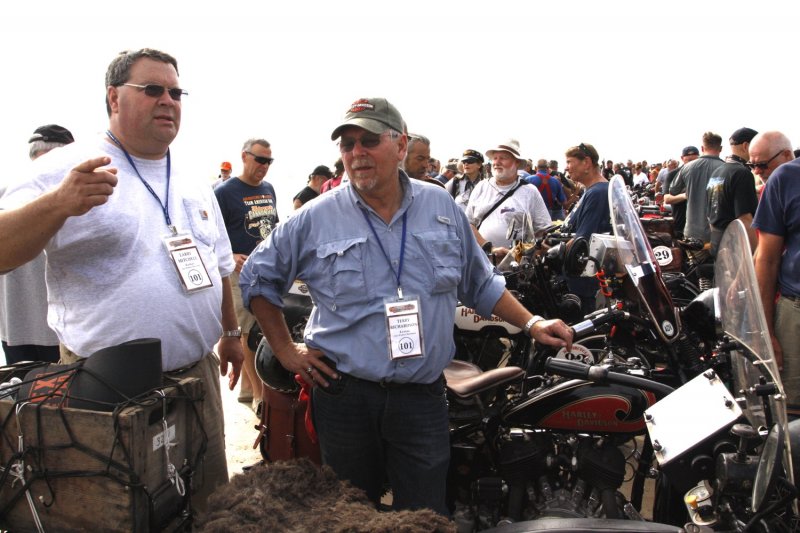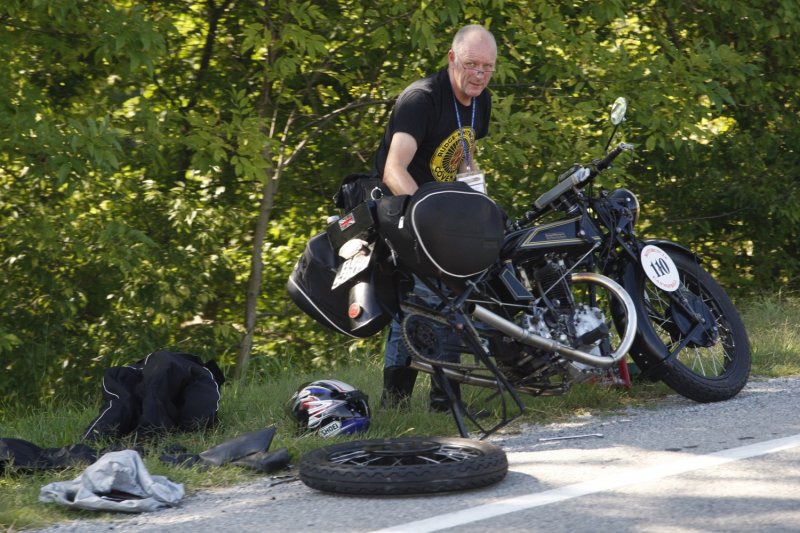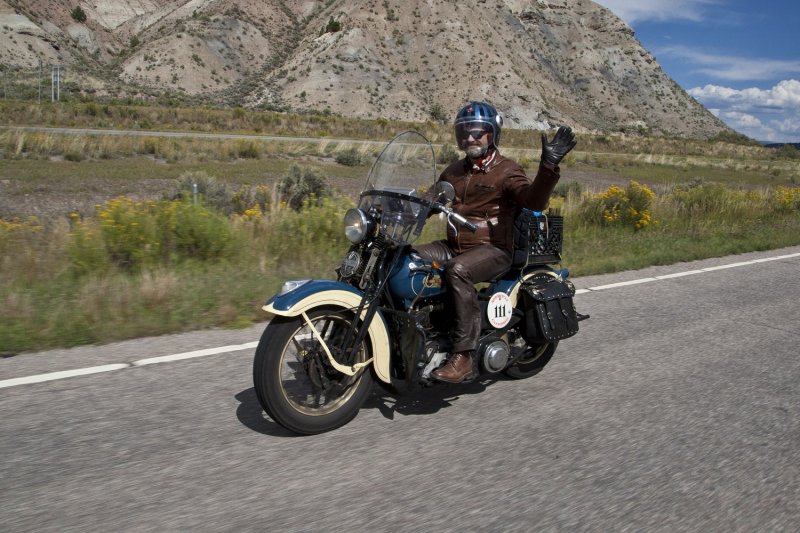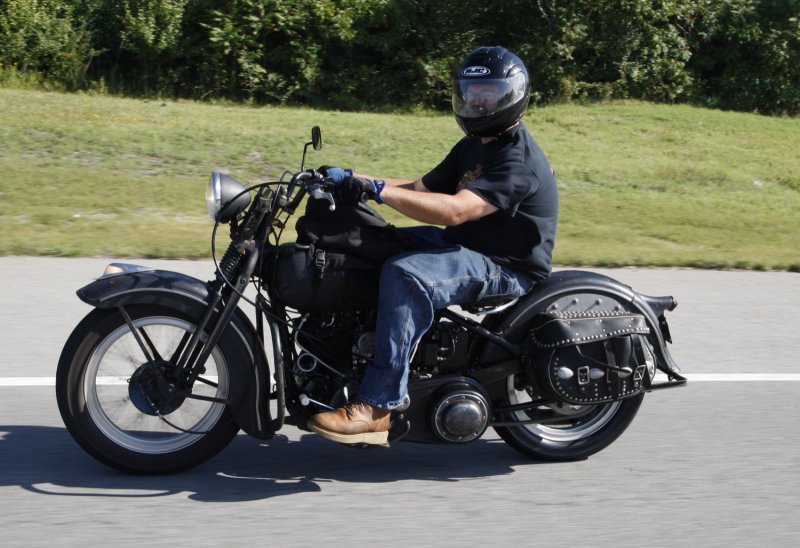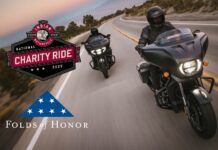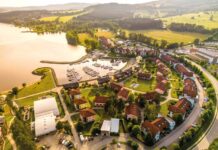Daytona Beach, Fla.–Tacoma, Wash., Sept. 5–21—They gathered in Daytona Beach, Florida, the motorcycle-riding fanatics with ancient iron, each anxious to strike out for new horizons. All 105 had paid their fees, made their bikes ready and journeyed from their homes to take the ride of a lifetime across America. Some came a great distance, shipping precious antique motorcycles from as far away as Germany, Italy and Poland. Most met for the first time on the sandy beach that would serve as the starting point; others were veterans of the two previous Motorcycle Cannonball runs and renewed their friendships. All would take to the carefully-mapped route for the first time. It was typical Florida weather: hot and muggy, and the atmosphere was thick with anticipation. With the green flag flapping in the warm sea breeze on a fall Friday, 101 riders charged off with wild abandon onto the back roads to experience the real America, one scenic mile at a time.
The diversified group had 17 days to complete their mission and not a single rider was anything less than optimistic, including the rider from Spain who had shipped his machine across the seas with a blown engine. By the time the broken bike arrived from customs, its anxious owner had already procured another engine from a California Cannonball rider and he and his fellow teammates set about getting the antique roadworthy. It was an ongoing task that would never see completion. The 1930 H-D logged a mere 58 total miles.
The Motorcycle Cannonball is an every-other-year endurance run that includes a grueling transcontinental route that has riders dipping their tire treads in the Atlantic and finishing on the shores of the Pacific Ocean. A different route is meticulously laid out by route master John Classen each year and the 2014 iteration would span 3,948 miles along a diagonal path that started in Florida and would end in Tacoma, Washington, over two weeks in the beginning of September. There would be one day of rest, which was spent in the very hospitable Midwest town of Junction City, Kansas, where residents rolled out the red carpet to welcome the weary riders.

Each Cannonball run has different cutoff years for the participating antiques; this run required motorcycles to be pre-1937. All marques were invited to share the road as the roving herd made their pilgrimage and the machines represented would include such common brands as Harley and Indian as well as lesser-known bikes like a 1923 Ner-a-car, a Sunbeam M9, Sokol 1000, and the Italian-made Moto Frera. A notable number of Henderson 4-cylinders also made the party. Competitive riders kept track of which brand performed best, but overall, the focus was on brotherhood. Even the most hardcore of the bunch made a point of reaching out to encourage his fellow rider and lend a hand where needed.
Originally, antique bikes were never built to sustain long and continuous abuse, so flogging a 70–100-year-old motorcycle to keep it chugging down the road as repeated 300-mile days were logged is no easy task, and parts for such antiquated machinery are tough to find. It’s not like a mechanic can just pop into a NAPA and pick up that special gasket or order up a new magneto from the local dealership. Consequently, many riders came prepared for every malfunction imaginable. Spare parts were lifeblood for these road warriors and support vehicles with rolling machine shops were stocked with every little component they could round up. Equipment included handy tools like welders, grinders and lathes. What wasn’t readily available was ingeniously fabricated. By the third day, with necessity being the mother of invention, rider #100, Pat Simmons, would find himself whittling an oil cap out of a stick of wood along a lonely stretch of Georgia bean fields.

Just down the road, Sharon Jacobs, one of four female riders that included three Americans and one woman from Italy, sat waiting for a sweep vehicle to scoop up her seized 1936 H-D. Her husband, Scott, was also a rider. He kissed his wife goodbye and left her behind as he continued on. Since points are based on miles covered over a timed route, he could not risk missing the check-in curfew. Emotions played no part in the fierce level of competition that wove its way through the heart of the event. As Sharon sat waiting in the sweltering sun, she tearfully shared that she’d received news that morning that her brother had passed away before she set a stiff upper lip and shifted her attention to the ailing motorcycle and her plans to get “Vinnie the VLH” back on the road. It would be another three days before parts were shipped and Sharon was back in the saddle. Her husband, however, would arrive in Tacoma on his 1926 H-D J with a perfect score.
Not everyone participated as part of a monster team with diesel pushers, spiffy air-conditioned shop trailers and mechanics with fully-stocked parts bins. Some came in vans or trucks with basics like spare tires and plenty of oil for the every-other-day fluid change that was required for the leaky old bikes. Some, like John Lanstrom on his 1928 BMW, came alone with just the tools they could carry in their saddlebags.

The bike styles came in configurations as diverse as those who rode them. Flashy riders from SoCal arrived on radical chopped Knuckleheads with king-and-queen seats, high sissy bars and raked front ends, and they were the visual extremes. Most riders had honored the vintage aspect and left their bikes as close to original as possible, but all had some form of personalized details. Many of the machines had names, like #13 Randy Aron’s bright orange 1929 JD named Lucille, #16 Ron Roberts’ 1936 Indian Chief with the crooked stick that flew an American flag adorned with Indian accents called Acceptance, or rider # 41 Mike Bell’s beloved Alice, a 1923 Harley J model. But none were as sweet as the tale told by David Lloyd about his 1919 H-D J named Lisa. A friend’s special-needs daughter had enthusiastically spent time hanging around the garage as the old Harley was made ready for the Cannonball. She became a beloved part of the crew and by the time of departure, Lloyd had named the bike after the beautiful girl with the precious heart. The dutiful # 54 carried her rider for 3,840 miles.
Colorado riders Gary Wright and his lovely lady Linda arrived on a 1930 Indian Chief with a sidecar, Robert Addis struggled to get his 1923 Ner-a-car over 35 mph each day, and three-time Cannonballer Shinya Kimura shared pilot duties on his 1915 Indian Twin with his best friend, Yoshi who has come from Japan for each of the MC runs. Shinya chose the Indian because it’s the same model his grandfather rode in Japan. He feels his revered grandfather’s spirit is with him as he rides.

There were father-and-son teams as well as husband-and-wife teams. Mr. and Mrs. Denis Sharon, married a mere three weeks prior, considered the run their honeymoon. Their groomsmen, Marty the dog and Sir Angus McDougal, both four-legged friends, were also on the run and kept fellow riders entertained with their tam-and-kilt outfits. New parents Matt and Brittney Olsen brought along the youngest member of the Cannonball family, their 5-month-old son Lockheed and Grandpa Carl, rider #84, helped with babysitting duties.
The speculation that there would actually be three very different runs going on within the confines of the event was heightened when the oldest bike, a 1914 H-D ridden by 71-year-old Victor Boocock, sputtered to the starting line. Divided into three categories, Class I included single-cylinder/single-speed belt-driven bikes with a displacement of 749cc or less. Class II was twin-cylinder/single-speed bikes, with either belts or chains and 750cc to 1000cc. Class III was made up of multi-cylinder/multi-speed bikes with transmissions and 1001cc or more displacement.

The difference between the classes meant the difference between a machine that could manage steep hills at reasonable speeds as opposed to one that would labor to clear small hills at a much slower pace. In case of a tie, the win would go to the oldest bike. In Victor’s case, his ancient machine performed admirably for 3,719 miles despite the two flats he suffered on the very first day and some engine trouble nine days later.

Safety is always the focus during the Cannonball, and for the first time a registered health care practitioner came along for the ride. Vicki Roberts-Sanfelipo, a registered nurse and director of Accident Scene Management, Inc., rode her own modern bike along the route and helped riders with things like bee stings, heat exhaustion and, in the case of three extremes, bike crashes. For Kansas rider Kelly Modlin, the accident included scrapes and broken ribs. His 1927 Henderson Deluxe was fished out of the ditch, straightened out and test ridden, and then handed back over to the dazed rider. Kelly would finish the day with a perfect score. The other two accidents required medical attention that would take the riders out of the run entirely.

The course took in some of the most exciting scenery the country has to offer a rider who putts along the back roads, and the weather was no less exciting. On the second day, the volatile and fickle climate of the South had riders staring down the throat of a tropical depression that caused flooding, resulting in a late start. Without point penalties, most riders trailered their machines to higher ground as they tried to outrun the storm, but some, like the stubborn Texan on a 1936 Indian, refused. Rider #44, Dennis Leggett, simply said, “We didn’t come all this way just to ride in a van. We ride in this stuff all the time back home and I’m riding in it now.” And he did. As a necessary precaution, he and his support crew, Mike, had smeared heavy grease over all the moisture-sensitive parts of his Scout and the old race bike performed perfectly. Both men were singing its praises by check-in that night in Georgia. Rain would continue to plague the run for many of the 16 days on the road. Cold and fog set in as they got into Kansas, skies cleared crossing into Colorado, but the temperatures remained low as the pack climbed the 12,000-foot Loveland Pass.

In all, determined road warriors hailing from 10 different countries would sputter through sections of the Smoky Mountains, across the muddy Mississippi into the Ozarks and across the plains. They crossed the Continental Divide three times while riding through the Rocky Mountains, the Moab region of Utah, the Salt Flats, the Columbia River Basin and the Cascade Mountain Range before coming to rest on the shores of Tacoma’s Puget Sound. The journey included 19 hosted parties at various dealerships, townships and friendly cities and as the group made their way across the continent, word carried ahead and excitement spread. People sat along the roads to catch a glimpse of the time travelers and gathered as welcoming committees at the evening stops.

Meanwhile, in parking lots overnight, entire engines were being torn apart and rebuilt so determined riders could greet the sun to ride another day. Exhausted Cannonballers reached out to each other with parts, tools, wisdom and encouragement—and brotherhood. Despite the grueling conditions, the spirit of the Cannonball is what carried the clan through as lifelong friendships were forged.
For those who had been a part of the original MCR, the exhilaration of the run was plenty enough to fuel the adrenaline rush, but to see run promoter Lonnie Isam ride along on his 1930 H-D VL pushed the excitement into the redline zone. Though he’d always dreamed of riding an antique across the states and spent countless hours organizing the run, other duties had taken priority in the past and he’d never been able to do so. Third time’s a charm, they say, and the joy of watching Lonnie become an active participant in his own vision gave another layer of enthusiasm to those who knew the back story.

Harley-Davidson has three officially licensed artists and all three men participate, on some level, in the Motorcycle Cannonball. Jeff Decker, a sculptor, and Scott Jacobs, a painter, rode in both the 2012 run as well as the 2014 iteration. Decker also participated in the 2010 run. This year, Decker invited fellow riders to stop by his studio in Utah to meet his family and see his collection. Painter David Uhl, H-D’s third artist, hosted an elaborate dinner at his studio and pulled out all the stops by offering massages to exhausted riders as well as giving away a choice of prints from his exhibited works.
The nomadic herd visited five museums over the span of 12 states: both the Coker Tire Museum in Chattanooga and the Cyclemos Motorcycle Museum in Red Boiling Spring are in Tennessee, the Rocky Mountain Motorcycle Museum is located in Colorado Springs, Colorado, and the Legends Motorcycle Museum is housed in Springville, Utah. The LeMay Museum in Tacoma, Washington, hosted the finish-line hysteria as ecstatic riders crossed the last mile of their 17-day odyssey. Some riders helped each other’s failed machines across the line in a symbolic gesture of completion and camaraderie. Just as in the 2012 run, participant Buck Carson pushed his failed motorcycle the last mile to symbolize his “finish what you start” attitude as the huge Texas state flag flapped in the breeze behind him. By run’s end, it would be South African rider #35, Hans Coertse, who would take home the first-place bronze statue that was sculpted by Jeff Decker. Hans was a second-time Cannonball rider whose Class I 1924 Indian Scout ran perfectly.

After a jubilant, celebratory banquet, riders tucked their bikes in securely and settled into hotel beds for the last official night of the most difficult antique motorcycle run in the world. As they slept, four Motorcycle Cannonball Run bikes and the support truck hooked to a 16-foot enclosed trailer was stolen. The trailer contained bike #73, a 1926 Harley-Davidson JD, #76 was a 1931 Harley-Davidson VL, and #99, a 1928 Harley-Davidson JD as well as #54, the beloved bike named Lisa. The outfit was stolen from the Hotel Murano in Tacoma. Between social media contacts, law enforcement and the men’s own legwork, the bikes and trailer were recovered in a matter of days, though some of the parts and gear are still unrecovered. The experience rattled Cannonball friends around the world. Like all the victims, David Lloyd’s just happy to have Lisa safe and sound, nestled among the mementos and memories of a fantastic journey across a continent with lifelong friends. (www.motorcyclecannonball.com)





